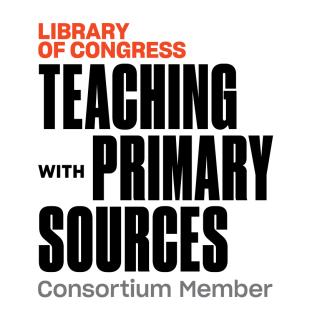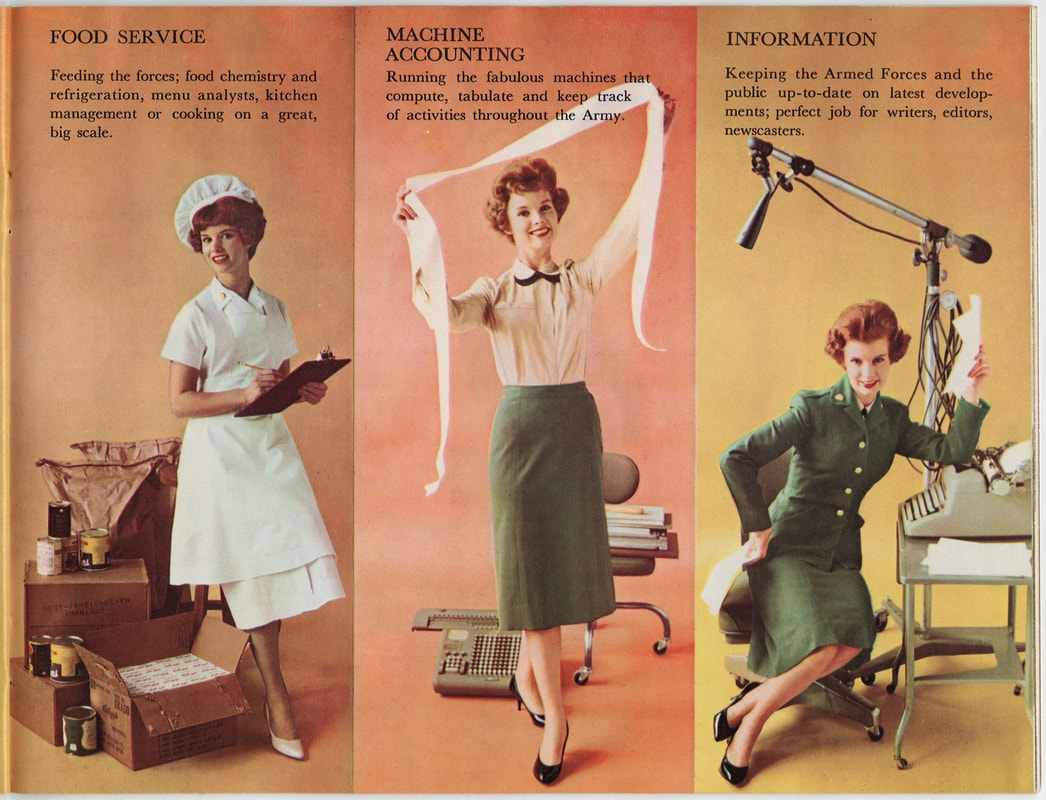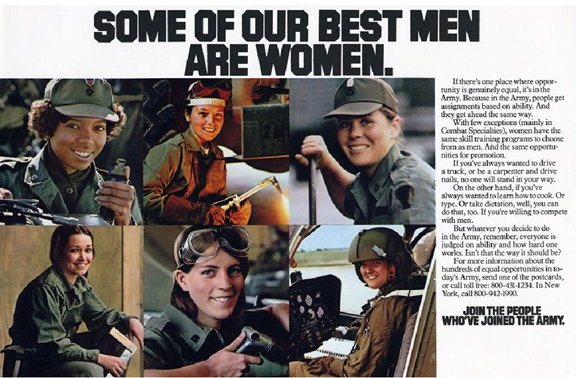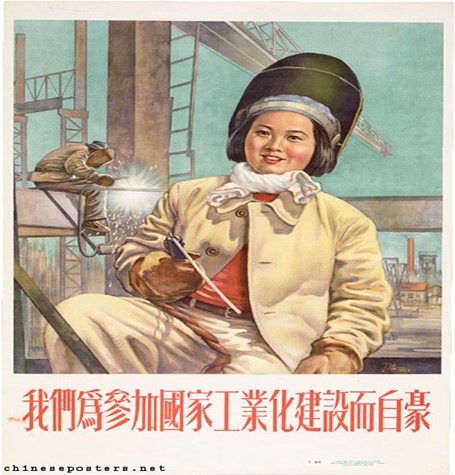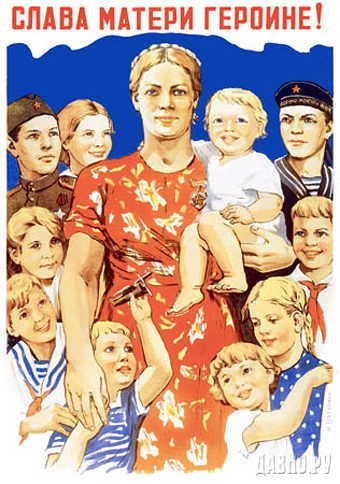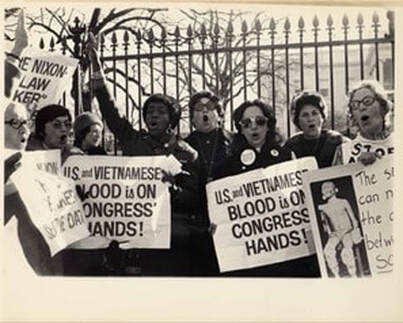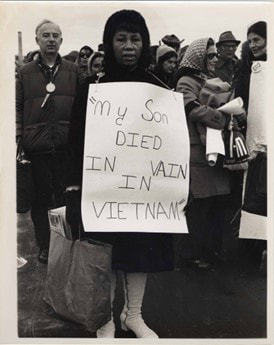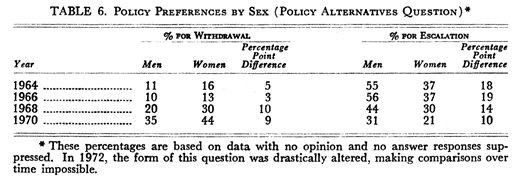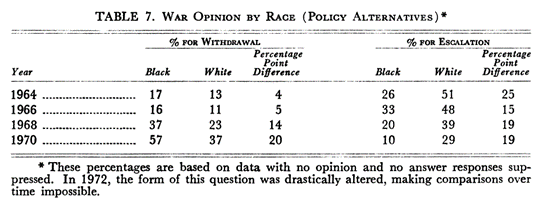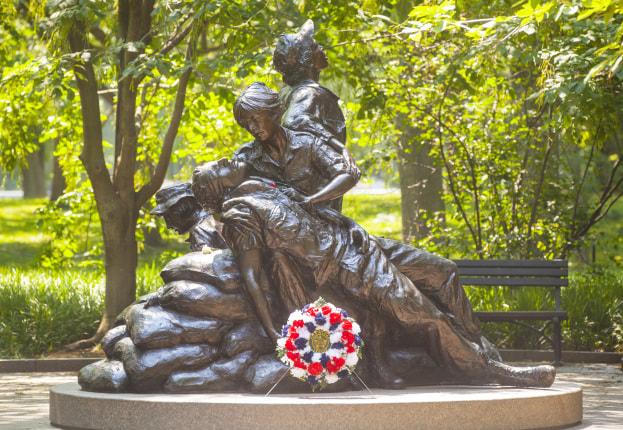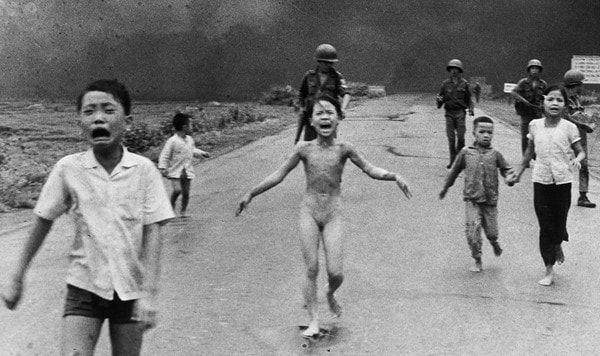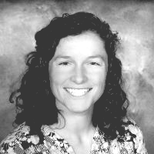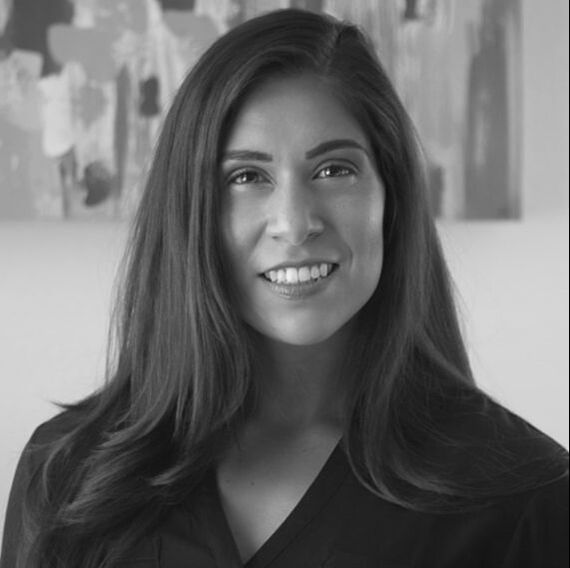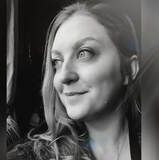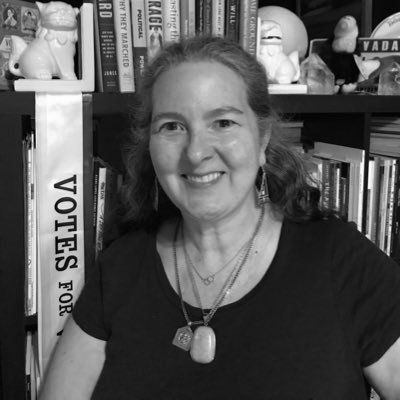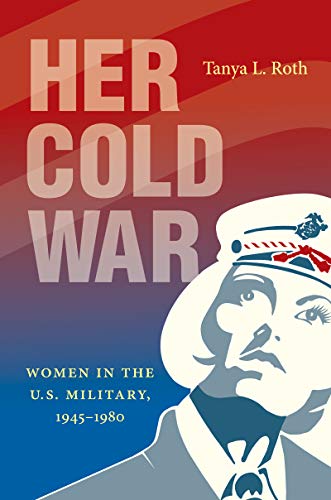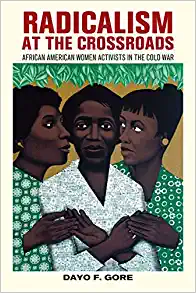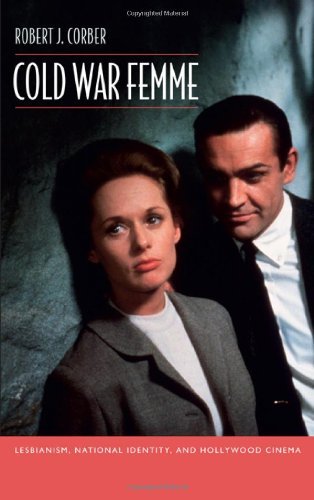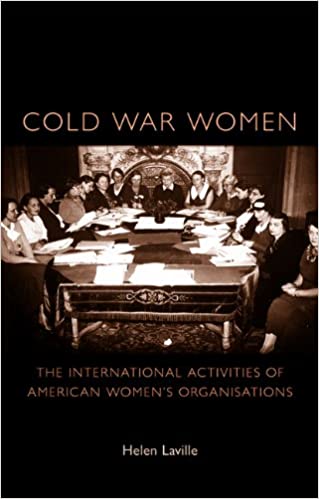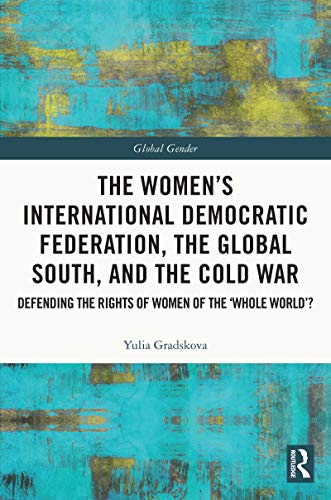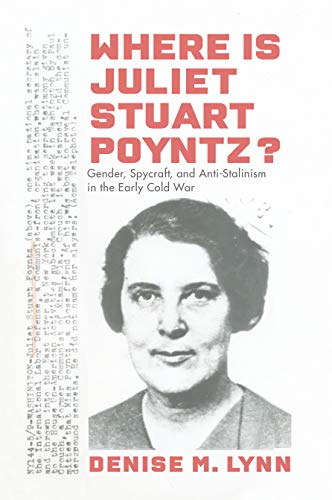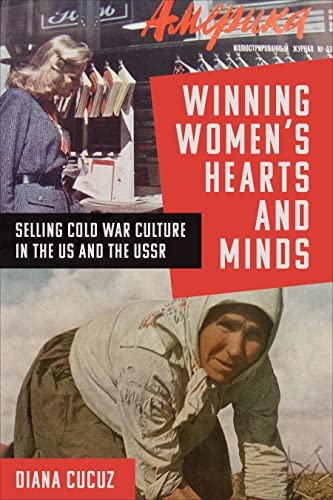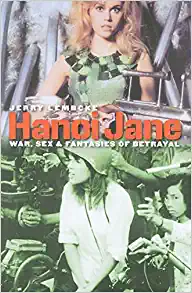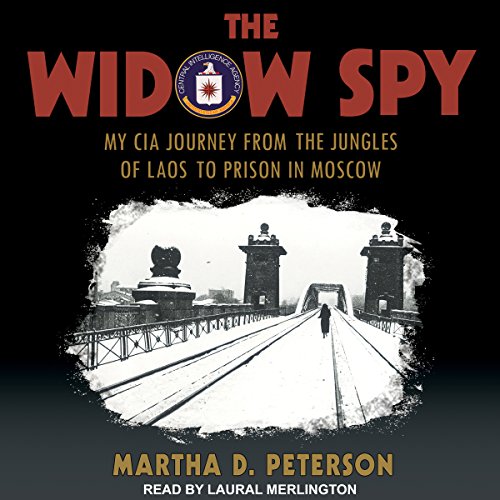22. Women and the Cold War
|
Women were pivotal in many aspects throughout the Cold War. They were soldiers, pilots, code breakers, nurses, and more. They supported the Cold War either on the front lines or from home. Of course not every woman supported war; in the Vietnam war many found themselves sympathetic with the Vietnamese women. Towards the end of the Cold War women found their social positions constantly changing, but sexism routinely held them back.
|
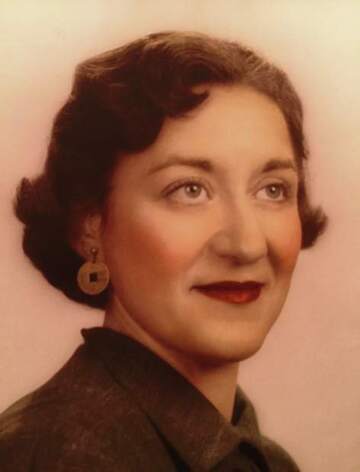 Angelina Nanni, National Archives
Angelina Nanni, National Archives
Following WWII, the US and its former ally, the Soviet Union, or USSR, entered into a Cold War. Though they were at odds, direct fighting between these two nuclear superpowers was somehow avoided. An “iron curtain” fell on Europe: dividing the eastern, totalitarian communists from the western, democratic capitalists. For the US, the Cold War was about stopping, or containing, the domino spread of totalitarianism and defending capitalism. For the Soviets, the Cold War was about stopping the corruption and exploitation of capitalism. Although the failures of communism would prove impossible to overcome, it was a long journey to the collapse of the USSR. In the meantime, the two superpowers backed opposite sides of many hot conflicts of the period. Some conflicts between the USSR and the US included the situations in Korea, Cuba, Vietnam, and many other disagreements. In the midst of these global crises, women played an important role.
Although tensions between the US and the USSR had long been present, this tension remained unnamed until the end of WWII. Though the US and USSR had, with their allies, defeated the Axis powers together, the US had also beat the Soviets in the race for nuclear power. Both countries’ rapidly advancing technologies launched them into a battle for nuclear supremacy, control of space, and passive influence around the world. The first major hot spot of the cold war was in Korea.
Many women were already working as cryptologists from WWII, so in the Cold War, the US took women’s roles a step farther and employed them as spies. Since the US was doing it, the USSR was likely using women too. Some of the most well known Soviet spies were women--including Ethel Rosenberg, executed with her husband in 1953 for passing atomic secrets to the Soviet Union. And it was American women working in counter intelligence who helped bring them down, including one particular woman Angeline Nanni. Women like Nanni unmasked many now infamous Soviet spies embedded in the British and German government. These spies’ work was so highly classified that President Harry Truman likely didn’t even know about it. These women didn’t look like your stereotypical spies. They carried handbags, played bridge, and liked to picnic. Most started out as school teachers with a deep mastery of language and math.
Although tensions between the US and the USSR had long been present, this tension remained unnamed until the end of WWII. Though the US and USSR had, with their allies, defeated the Axis powers together, the US had also beat the Soviets in the race for nuclear power. Both countries’ rapidly advancing technologies launched them into a battle for nuclear supremacy, control of space, and passive influence around the world. The first major hot spot of the cold war was in Korea.
Many women were already working as cryptologists from WWII, so in the Cold War, the US took women’s roles a step farther and employed them as spies. Since the US was doing it, the USSR was likely using women too. Some of the most well known Soviet spies were women--including Ethel Rosenberg, executed with her husband in 1953 for passing atomic secrets to the Soviet Union. And it was American women working in counter intelligence who helped bring them down, including one particular woman Angeline Nanni. Women like Nanni unmasked many now infamous Soviet spies embedded in the British and German government. These spies’ work was so highly classified that President Harry Truman likely didn’t even know about it. These women didn’t look like your stereotypical spies. They carried handbags, played bridge, and liked to picnic. Most started out as school teachers with a deep mastery of language and math.
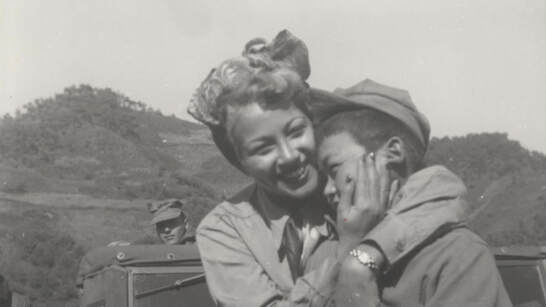 American Woman with a Korean child during the Korean War, Korean War Legacy Foundation
American Woman with a Korean child during the Korean War, Korean War Legacy Foundation
But peace was not a reality. After Japan collapsed, the US tried to defend the formerly Japanese-occupied Korea from communist takeover.
At the time, 120,000 women were on active duty in Korea. A third of them were healthcare providers, while the remainder were Women’s Army Corps (WACs), Women in the Air Force (WAFs), Navy Women’s Reserves and Women Marines. Many of these women had already been involved in WWII, they simply continued their duty. Also, Congress passed the Women’s Armed Services Integration Act in 1948, just two years before the outbreak of hostilities in Korea. The act opened the door for women to serve in the armed services on a more permanent basis. Sadly, 18 women died during the Korean War in service to the US.
A war medic, Shirley Gates McBride observed that the army treated women pretty equally, at least in regard to pay. “[We got] the same pay. You were not a female soldier, you were a soldier. And, you were a ‘corpsman’, not a ‘corpswoman.’ It was ‘yes, ma’am and ‘no, ma’am,’ and ‘yes, sir’ and ‘no, sir.’”
Private Doris Porpiglia recalled her time in the Army. While her immediate family was proud of her, her aunt was not and told her it wasn’t a ladies place. Porpiglia replied, “I am more of a lady than you’ll ever be!” Does war have anything to do with being a lady or a man?
A Navy recruiter, Patricia Johnson of Sterling, VA, believed that the growing acceptance of women in this traditionally male field was not only significant to the military field itself--but led to women’s advancement in broader society.
The Korean conflict was long and difficult. The war started and ended with neither side gaining much territory. However, Korea was only the opening act to the Vietnam war that would almost immediately follow.
At the time, 120,000 women were on active duty in Korea. A third of them were healthcare providers, while the remainder were Women’s Army Corps (WACs), Women in the Air Force (WAFs), Navy Women’s Reserves and Women Marines. Many of these women had already been involved in WWII, they simply continued their duty. Also, Congress passed the Women’s Armed Services Integration Act in 1948, just two years before the outbreak of hostilities in Korea. The act opened the door for women to serve in the armed services on a more permanent basis. Sadly, 18 women died during the Korean War in service to the US.
A war medic, Shirley Gates McBride observed that the army treated women pretty equally, at least in regard to pay. “[We got] the same pay. You were not a female soldier, you were a soldier. And, you were a ‘corpsman’, not a ‘corpswoman.’ It was ‘yes, ma’am and ‘no, ma’am,’ and ‘yes, sir’ and ‘no, sir.’”
Private Doris Porpiglia recalled her time in the Army. While her immediate family was proud of her, her aunt was not and told her it wasn’t a ladies place. Porpiglia replied, “I am more of a lady than you’ll ever be!” Does war have anything to do with being a lady or a man?
A Navy recruiter, Patricia Johnson of Sterling, VA, believed that the growing acceptance of women in this traditionally male field was not only significant to the military field itself--but led to women’s advancement in broader society.
The Korean conflict was long and difficult. The war started and ended with neither side gaining much territory. However, Korea was only the opening act to the Vietnam war that would almost immediately follow.
 Juanita Moody, Public Domain
Juanita Moody, Public Domain
The Cuban Missile Crisis of 1962:
Juanita Moody was one of the few US women who had risen the ranks in cryptology and was actually in charge of a unit. It was her team that discovered that there was something suspicious going on in Cuba. She could see ships from the USSR bringing in supplies under the cover of night. Plus microwave towers were being installed. It was Moody’s report that was taken to the White House. President JFK read it, but she worried not enough was being done. So she pressed the NSA to make an unprecedented move–publishing the info to the larger intelligence community. She said, “It has reached the point that I am more worried about the trouble we’re going to get in having not published it, because someday we’re going to have to answer for this. And if we do....”
The report thankfully pushed the government to investigate. They flew U2 planes over Cuba and saw nuclear launch sites. Cuba was not a nuclear country, so where were these weapons coming from? The presence of nuclear weapons in Cuba was particularly troublesome, because of its proximity to the continental United States.
As the crisis continued, Moody spent sleepless nights on a cot in her office. The Soviets sailed for Cuba with nuclear weapons. The US installed a naval blockade. Moody used a new technology called teletype to pass the most current, relevant, top secret information from her team to the powers that be. With ships facing off and active war as close as it could be, Kennedy struck a deal with the Soviet’s leader Khrushchev. He would remove weapons from Turkey so long as the Soviets would not bring their weapons to Cuba. The crisis was averted.
Moody received the Federal Woman’s Award, established to honor “leadership, judgment, integrity, and dedication” among female government employees. Despite being the brains behind the most dangerous moment in human history when she was asked about her past by those outside the intelligence community, Moody would humbly say, “Oh, I’ve done lots of interesting things for a country girl from North Carolina.”
But being a woman at the National Security Agency was challenging. Female leaders were often alone in a world of men and subject to sexual harassment or worse by their male colleagues. To make matters worse, women typically had few options for complaint. Even Juanita Moody was frequently harassed, overlooked for promotion, and once spoon fed at a party as a joke.
Juanita Moody was one of the few US women who had risen the ranks in cryptology and was actually in charge of a unit. It was her team that discovered that there was something suspicious going on in Cuba. She could see ships from the USSR bringing in supplies under the cover of night. Plus microwave towers were being installed. It was Moody’s report that was taken to the White House. President JFK read it, but she worried not enough was being done. So she pressed the NSA to make an unprecedented move–publishing the info to the larger intelligence community. She said, “It has reached the point that I am more worried about the trouble we’re going to get in having not published it, because someday we’re going to have to answer for this. And if we do....”
The report thankfully pushed the government to investigate. They flew U2 planes over Cuba and saw nuclear launch sites. Cuba was not a nuclear country, so where were these weapons coming from? The presence of nuclear weapons in Cuba was particularly troublesome, because of its proximity to the continental United States.
As the crisis continued, Moody spent sleepless nights on a cot in her office. The Soviets sailed for Cuba with nuclear weapons. The US installed a naval blockade. Moody used a new technology called teletype to pass the most current, relevant, top secret information from her team to the powers that be. With ships facing off and active war as close as it could be, Kennedy struck a deal with the Soviet’s leader Khrushchev. He would remove weapons from Turkey so long as the Soviets would not bring their weapons to Cuba. The crisis was averted.
Moody received the Federal Woman’s Award, established to honor “leadership, judgment, integrity, and dedication” among female government employees. Despite being the brains behind the most dangerous moment in human history when she was asked about her past by those outside the intelligence community, Moody would humbly say, “Oh, I’ve done lots of interesting things for a country girl from North Carolina.”
But being a woman at the National Security Agency was challenging. Female leaders were often alone in a world of men and subject to sexual harassment or worse by their male colleagues. To make matters worse, women typically had few options for complaint. Even Juanita Moody was frequently harassed, overlooked for promotion, and once spoon fed at a party as a joke.
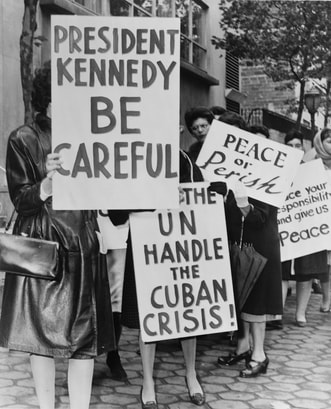 Women Strike for Peace, Wikimedia Commons
Women Strike for Peace, Wikimedia Commons
Women Strike for Peace:
The Cuban Missile Crisis was terrifying to live through. It led many people to join the growing peace movement opposed to nuclear proliferation– after all, Earth could not survive a hot conflict between the US and USSR. Claudia Jones became a leader in the peace movement. She was an immigrant communist herself and an outspoken advocate for peace. She believed that war and nuclear weapons were capitalist tools to limit freedom struggles, contain non-white populations globally, and undermine women's liberties. She argued women’s leadership was essential in the peace movement.
As actual war was becoming more of a reality around the globe, women worked tirelessly toward anti-proliferation. In 1959, Members of the Greater St. Louis Citizens Committee for Nuclear Information, along with some schools of dentistry worked to show how radioactive fallout from nuclear testing in Nevada was entering the food and milk supply and significantly impacting children’s health. Women across the country collected and donated 320,000 baby teeth for the research. In 1963, they released the titled “Tooth Fairy” study that showed babies born after testing began were 50 times more likely to have cancer causing chemicals in their teeth.
Bella Abzug and Dagmar Wilson were founders of Women Strike for Peace, a peace activist group with the goal of stopping nations from nuclear testing to slow down the arms race. On November 1, 1961 Women Strike for Peace got 50,000 women marching onto the streets. It was the largest national women’s peace protest of the 20th century. Leading ladies, Jackie Kennedy and Nina Khrushchev both supported this work. Coretta Scott King was a delegate for Women Strike for Peace at the disarmament conference, stating, “We are on the brink of destroying ourselves through nuclear warfare.” King convinced the USSR and the west into signing the Limited Nuclear Test-Ban Treaty.
This work was incredibly important to disrupting gender norms, women were pushing themselves into topics of national security policy. And on that topic there were significant gender divides. Only 38 percent of American women supported nuclear testing, compared to 58 percent of men.
The Cuban Missile Crisis was terrifying to live through. It led many people to join the growing peace movement opposed to nuclear proliferation– after all, Earth could not survive a hot conflict between the US and USSR. Claudia Jones became a leader in the peace movement. She was an immigrant communist herself and an outspoken advocate for peace. She believed that war and nuclear weapons were capitalist tools to limit freedom struggles, contain non-white populations globally, and undermine women's liberties. She argued women’s leadership was essential in the peace movement.
As actual war was becoming more of a reality around the globe, women worked tirelessly toward anti-proliferation. In 1959, Members of the Greater St. Louis Citizens Committee for Nuclear Information, along with some schools of dentistry worked to show how radioactive fallout from nuclear testing in Nevada was entering the food and milk supply and significantly impacting children’s health. Women across the country collected and donated 320,000 baby teeth for the research. In 1963, they released the titled “Tooth Fairy” study that showed babies born after testing began were 50 times more likely to have cancer causing chemicals in their teeth.
Bella Abzug and Dagmar Wilson were founders of Women Strike for Peace, a peace activist group with the goal of stopping nations from nuclear testing to slow down the arms race. On November 1, 1961 Women Strike for Peace got 50,000 women marching onto the streets. It was the largest national women’s peace protest of the 20th century. Leading ladies, Jackie Kennedy and Nina Khrushchev both supported this work. Coretta Scott King was a delegate for Women Strike for Peace at the disarmament conference, stating, “We are on the brink of destroying ourselves through nuclear warfare.” King convinced the USSR and the west into signing the Limited Nuclear Test-Ban Treaty.
This work was incredibly important to disrupting gender norms, women were pushing themselves into topics of national security policy. And on that topic there were significant gender divides. Only 38 percent of American women supported nuclear testing, compared to 58 percent of men.
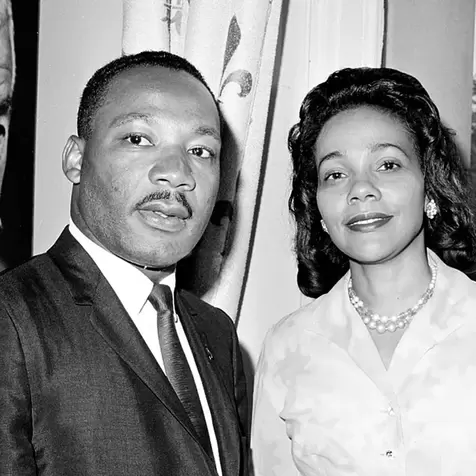 Coretta Scott King, The Guardian
Coretta Scott King, The Guardian
In 1962, newspapers said, “[f]or the most part, they stress femininity rather than feminism.” Their feminine and maternal demeanor got attention and allowed them to achieve radical change. They were empowered by success of effectively working together and many became involved in the second wave feminist movement.
Vietnam War:
American involvement in the Vietnam war was complicated. Vietnam’s struggle for independence against their colonizer, France, was severely drawn out. When France withdrew from Vietnam in 1954, the US feared the spread of communism in Southeast Asia. They began financial and covert initiatives to defend South Vietnam from its northern communist neighbor. When one of the US’s secret missions in the Gulf of Tonkin was uncovered, the Communists attacked. In an unprecedented move, Congress approved the Tonkin Resolution, which allowed the US to begin fighting an undeclared war: a war that involved women on both sides of the globe.
The reasons for US involvement in Vietnam were ambiguous, even to US citizens at the time. The 1950’s and 60’s showed an interesting blend of generational differences, with many older WWII Veterans raised on the patriotic ideal that when your country called, you responded. But younger generations, mothers, and civil rights activists were challenging the norms of their parents.
Vietnam War:
American involvement in the Vietnam war was complicated. Vietnam’s struggle for independence against their colonizer, France, was severely drawn out. When France withdrew from Vietnam in 1954, the US feared the spread of communism in Southeast Asia. They began financial and covert initiatives to defend South Vietnam from its northern communist neighbor. When one of the US’s secret missions in the Gulf of Tonkin was uncovered, the Communists attacked. In an unprecedented move, Congress approved the Tonkin Resolution, which allowed the US to begin fighting an undeclared war: a war that involved women on both sides of the globe.
The reasons for US involvement in Vietnam were ambiguous, even to US citizens at the time. The 1950’s and 60’s showed an interesting blend of generational differences, with many older WWII Veterans raised on the patriotic ideal that when your country called, you responded. But younger generations, mothers, and civil rights activists were challenging the norms of their parents.
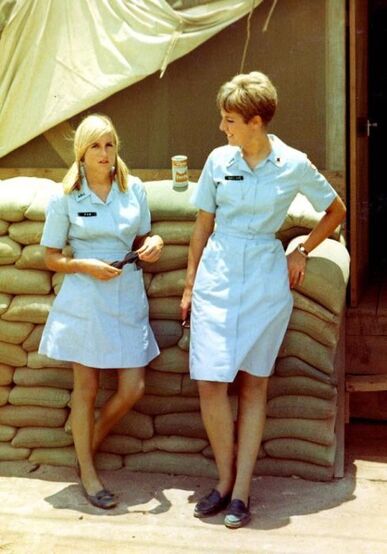 Doughnut Dollies
Doughnut Dollies
American nurses began training South Vietnamese nurses as early as 1956. Over the course of the Vietnam war, five nurses died, including 52-year-old Lieutenant Colonel Annie Ruth Graham, who served as a military nurse in both World War II and Korea before Vietnam. Sharon Ann Lane of Canton, Ohio was the only nurse killed in Vietnam as a result of enemy fire. Lane was posthumously awarded the Vietnamese Gallantry Cross with Palm and the Bronze Star for Heroism.
Five Navy nurses were wounded when the Communist Viet Cong bombed an officer’s quarters in the southern capital of Saigon on Christmas Eve 1964. They were each awarded the Purple Heart and became the first female members of the U.S. Armed Forces to receive that award in the war. Commander Elizabeth Barrett became the first female naval line officer to hold command in a combat zone in 1972.
The motivations for joining varied from military benefits to pay for nursing school to fulfilling the challenge posed by President Kennedy to “ask what you can do for your country.” Astoundingly, nurses in the military were all volunteers.
In 1962, the American Red Cross began sending volunteers to Vietnam to provide medical support and “a touch of home” to soldiers in the field. Affectionately called “Doughnut Dollies” by the troops, more than 1,200 women served on major bases and remote landing zones. They brought games, refreshments, and activities to tired soldiers who needed a break from the war. Women were sexually objectified and asked to act the “girl next door” to uplift the depleted soldiers.
Five Navy nurses were wounded when the Communist Viet Cong bombed an officer’s quarters in the southern capital of Saigon on Christmas Eve 1964. They were each awarded the Purple Heart and became the first female members of the U.S. Armed Forces to receive that award in the war. Commander Elizabeth Barrett became the first female naval line officer to hold command in a combat zone in 1972.
The motivations for joining varied from military benefits to pay for nursing school to fulfilling the challenge posed by President Kennedy to “ask what you can do for your country.” Astoundingly, nurses in the military were all volunteers.
In 1962, the American Red Cross began sending volunteers to Vietnam to provide medical support and “a touch of home” to soldiers in the field. Affectionately called “Doughnut Dollies” by the troops, more than 1,200 women served on major bases and remote landing zones. They brought games, refreshments, and activities to tired soldiers who needed a break from the war. Women were sexually objectified and asked to act the “girl next door” to uplift the depleted soldiers.
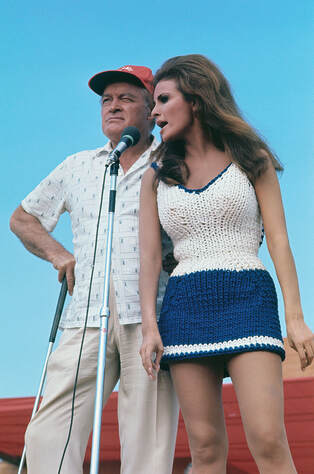 Bob Hope with Raquel Welch, Public Domain
Bob Hope with Raquel Welch, Public Domain
Women also served as members of the U.S. Air Force Nurse Corps and the Women’s Air Force (WAF) during the Vietnam conflict. Captain Mary Therese Klinker was killed in a crash in April 1975 near Saigon, 138 people were killed including many Vietnamese children and a number of female civilians working for U.S. government agencies. Captain Klinker was posthumously awarded the Airman’s Medal for Heroism and the Meritorious Service Medal.
Within the military, some women spoke out against the war, but they also articulated more general grievances, including sexual harassment and unequal treatment in all branches of the service. They criticized the pervasive sexism that regarded women as inferior soldiers and kept them in subordinate positions. Many women who voiced their concerns were subjected to surveillance, restrictions, undesirable job assignments, and excessive charges filed against them for minor infractions.
The United Service Organization provided entertainment and programs to support military morale in combat zones since 1941. The best-known provider of USO entertainment programs was Bob Hope. Starting in 1964, Hope brought his shows to Vietnam nine times. While he was the main event, Hope’s shows featured female stars who were sexualized as rewards for the brave men fighting abroad.
On the home front, some women supported the war effort as a crusade against communism. They engaged in protests and called on the military to achieve total victory. Women in conservative organizations such as Young Americans for Freedom, along with women whose interest in the war was in bringing their loved ones home, raised their voices in support of soldiers and the politics of anti-communism.
Vietnam impacted the lives of so many Americans, but it was also a distant war. New technologies like TV helped bring the faraway conflict home to the American people. Americans on the nightly news could actually see how the conflict was impacting everyday citizens in Vietnam–especially the women.
Within the military, some women spoke out against the war, but they also articulated more general grievances, including sexual harassment and unequal treatment in all branches of the service. They criticized the pervasive sexism that regarded women as inferior soldiers and kept them in subordinate positions. Many women who voiced their concerns were subjected to surveillance, restrictions, undesirable job assignments, and excessive charges filed against them for minor infractions.
The United Service Organization provided entertainment and programs to support military morale in combat zones since 1941. The best-known provider of USO entertainment programs was Bob Hope. Starting in 1964, Hope brought his shows to Vietnam nine times. While he was the main event, Hope’s shows featured female stars who were sexualized as rewards for the brave men fighting abroad.
On the home front, some women supported the war effort as a crusade against communism. They engaged in protests and called on the military to achieve total victory. Women in conservative organizations such as Young Americans for Freedom, along with women whose interest in the war was in bringing their loved ones home, raised their voices in support of soldiers and the politics of anti-communism.
Vietnam impacted the lives of so many Americans, but it was also a distant war. New technologies like TV helped bring the faraway conflict home to the American people. Americans on the nightly news could actually see how the conflict was impacting everyday citizens in Vietnam–especially the women.
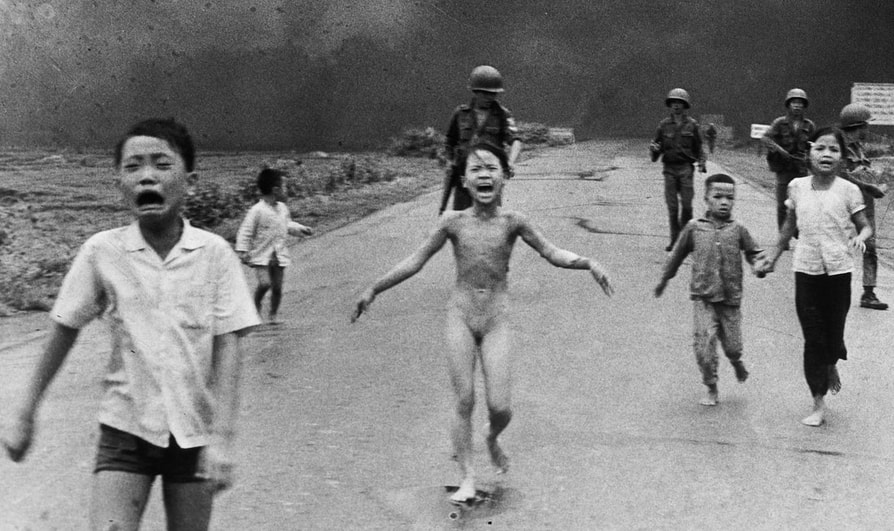 "Napalm Girl" Phan Thi Kim Phuc, Wikimedia Commons
"Napalm Girl" Phan Thi Kim Phuc, Wikimedia Commons
Diane Nash, a civilian leader in the civil rights movement, visited Vietnam in December 1966 along with 3 other American women and each brought back stories to the media describing what they saw. This was just one of many such "fact-finding" missions undertaken by US citizens early in the conflict in order to report on a war that wasn't receiving the kind of coverage they wanted.
Like WWII before it, there were many ways women proved integral to the Vietnam War. Despite the precedent set by female correspondents in prior wars, they were not always accepted in the field. Nevertheless, women reported, including Gloria Emerson for The New York Times. She received many awards and was praised for her stories.
Pictures of struggling Vietnamese people helped turn the war into one of the most controversial periods of US history. By 1972 many had turned against the war and one particularly powerful image that affected Americans was the photograph of a young Vietnamese girl running to escape napalm, the “liquid fire” that had severely burned her back. Nine years old at the time, the naked and vulnerable “Napalm Girl” symbolized the impact of American war technology on everyday Vietnamese people. This photo solidified the imbalance power dynamic between the United States and the small Southeast Asian nation, already torn by civil war. We now know that the girl in the photograph is Phan Thi Kim Phuc from Trang Bang in South Vietnam. While visuals of Vietnam were startling, the horrors of war could not so easily be glorified when US citizens now had evidence of so many innocent women and children suffering.
The Vietnam War became increasingly unpopular. Tens of thousands of Americans were being drafted and dying every month in a war few could identify a purpose for. As the Vietnam War dragged on into the late-1960s and early 70s, women, especially college women and middle-aged, middle-class white mothers, were increasingly active in the anti-war movement. Organizations such as Students for a Democratic Society (SDS), founded in 1960 and active at as many as three hundred colleges, staged campus demonstrations against military recruitment, war research, and the war altogether. Their opposition stemmed from their opposition to broader Cold War logic.
Like WWII before it, there were many ways women proved integral to the Vietnam War. Despite the precedent set by female correspondents in prior wars, they were not always accepted in the field. Nevertheless, women reported, including Gloria Emerson for The New York Times. She received many awards and was praised for her stories.
Pictures of struggling Vietnamese people helped turn the war into one of the most controversial periods of US history. By 1972 many had turned against the war and one particularly powerful image that affected Americans was the photograph of a young Vietnamese girl running to escape napalm, the “liquid fire” that had severely burned her back. Nine years old at the time, the naked and vulnerable “Napalm Girl” symbolized the impact of American war technology on everyday Vietnamese people. This photo solidified the imbalance power dynamic between the United States and the small Southeast Asian nation, already torn by civil war. We now know that the girl in the photograph is Phan Thi Kim Phuc from Trang Bang in South Vietnam. While visuals of Vietnam were startling, the horrors of war could not so easily be glorified when US citizens now had evidence of so many innocent women and children suffering.
The Vietnam War became increasingly unpopular. Tens of thousands of Americans were being drafted and dying every month in a war few could identify a purpose for. As the Vietnam War dragged on into the late-1960s and early 70s, women, especially college women and middle-aged, middle-class white mothers, were increasingly active in the anti-war movement. Organizations such as Students for a Democratic Society (SDS), founded in 1960 and active at as many as three hundred colleges, staged campus demonstrations against military recruitment, war research, and the war altogether. Their opposition stemmed from their opposition to broader Cold War logic.
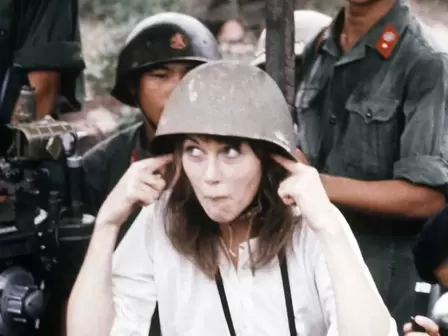 Jane Fonda, Public Domain
Jane Fonda, Public Domain
By 1969, frustration with America’s continuing involvement in Vietnam led SDS to demand more direct action. Bernardine Dohrn led an SDS faction that published a manifesto entitled, “You Don’t Need a Weatherman to Know Which Way the Wind Blows” in New Left Notes. This document made the case for revolution. Dohrn was also active in the Weather Underground, a group committed to answering the violence of the war with violence here at home, including bombings at university buildings.
By 1970, Dohrn was on the FBI’s Most Wanted List, where she remained for several years. Participation in SDS and the Weather Underground inspired some women to join radical feminist groups, as they frequently felt that their voices in the radical anti-war movement were not heard.
Some celebrity women protested American involvement in the Vietnam War. The most prominent of these women were Joan Baez and Jane Fonda.
Joan Baez was vocal in the anti-draft movement. She helped promote the slogan, “Girls say yes to boys who say no.” This use of female sexuality was semi-problematic, but gave root to the feminist movement of the 1970s.
Fonda participated in a troupe of actors and musicians that performed under the name, ”Free the Army”” (more frequently, “F the Army”) that provided entertainment for soldiers in coffee houses near military bases. In May of 1970, Fonda distributed copies of a GI anti-war newspaper, Fatigue Press, at Ford Hood. She was arrested and barred from the base, but she spoke out against the fact that soldiers were prohibited from possessing anti-war literature.
By 1970, Dohrn was on the FBI’s Most Wanted List, where she remained for several years. Participation in SDS and the Weather Underground inspired some women to join radical feminist groups, as they frequently felt that their voices in the radical anti-war movement were not heard.
Some celebrity women protested American involvement in the Vietnam War. The most prominent of these women were Joan Baez and Jane Fonda.
Joan Baez was vocal in the anti-draft movement. She helped promote the slogan, “Girls say yes to boys who say no.” This use of female sexuality was semi-problematic, but gave root to the feminist movement of the 1970s.
Fonda participated in a troupe of actors and musicians that performed under the name, ”Free the Army”” (more frequently, “F the Army”) that provided entertainment for soldiers in coffee houses near military bases. In May of 1970, Fonda distributed copies of a GI anti-war newspaper, Fatigue Press, at Ford Hood. She was arrested and barred from the base, but she spoke out against the fact that soldiers were prohibited from possessing anti-war literature.
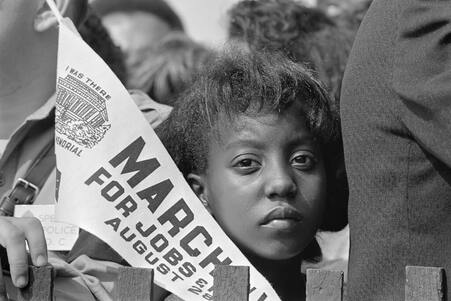 Gwen Patton, Public Domain
Gwen Patton, Public Domain
In 1972, Fonda traveled to North Vietnam and posed with soldiers, both men and women, on an anti-aircraft gun used against American bombing raids. She spent two weeks in the north and spoke on the Voice of Vietnam radio, imploring the United States to stop the bombing that was destroying farmland, eliminating the livelihood of local farm families. She also spoke with American prisoners of war and reported that they urged their families to vote for George McGovern in the 1972 presidential election. Upon her return, Fonda was hailed as a hero by some but also broadly accused of treason. Even now, years later, her critics decry her as “Hanoi Jane.”
For women of color the war in Vietnam was difficult. Black Power groups had long adopted an anti-imperialist agenda and found that American policies had always exploited people of color globally. They had no quarrel with the indigenous people of Vietnam.
One of the most far reaching and effective black anti-war groups was the National Black Anti-War Anti-Draft Union spearheaded by Gwen Patton. She had long been involved in Civil Rights work and felt activists needed an organization that fought at the intersection of racism and imperialism.
For women of color the war in Vietnam was difficult. Black Power groups had long adopted an anti-imperialist agenda and found that American policies had always exploited people of color globally. They had no quarrel with the indigenous people of Vietnam.
One of the most far reaching and effective black anti-war groups was the National Black Anti-War Anti-Draft Union spearheaded by Gwen Patton. She had long been involved in Civil Rights work and felt activists needed an organization that fought at the intersection of racism and imperialism.
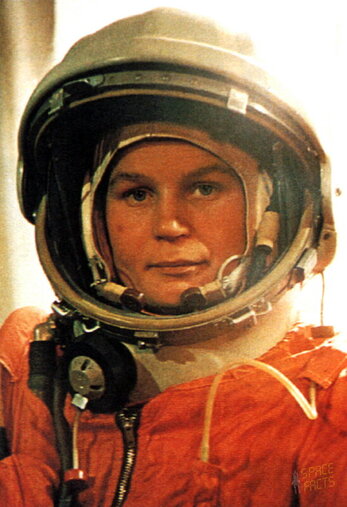 Valentina Tereshkova, Wikimedia Commons
Valentina Tereshkova, Wikimedia Commons
Elaine Brown, the only female chairperson for the Black Panther Party, traveled to Vietnam. Her trip helped shape the Panther position on the war. She said, “we were not anti-war activists in the sense that we thought there should just be peace in Vietnam. Our position became very clear and very strong as it evolved. And that was victory for the Viet--Vietnamese, victory for the Vietcong, which was not a very popular position.”
On a broad scale, the relationship of women to the War in Vietnam reflected the relationships of all Americans to the conflict that took more than 58,000 American lives. Whether Vietnamese or American, women fought hard in Vietnam. Meanwhile, some women at home supported and others opposed the war, Some were willing to carry their convictions to radical acts. Most importantly, the actions of American women in the late 1960s and 70s paved the way for changes in society including feminist fervor that created the world we live in today.
Women in the Space Race:
As Soviet space exploration was far exceeding American capabilities, President Kennedy set the challenge of getting a “man” on the moon by the end of the decade. Meanwhile over in the USSR, Soviet Cosmonaut Valentina Tereshkova, had already become the first woman in space in 1963. Excitingly, thousands of women were still behind the space race in the US. Women computers helped to solidify the math that made the accomplishment possible. Those women included women of color like Mary Jackson, Katherine Johnson, and Dorothy Vaughan, who faced the double challenge of race and gender in a white-male dominated world. Another woman, Margaret Hamilton, led the team behind the code that took the spacecraft to the moon. Much later in life, she was awarded a Presidential Medal of Freedom by President Barack Obama for her work on Apollo.
On a broad scale, the relationship of women to the War in Vietnam reflected the relationships of all Americans to the conflict that took more than 58,000 American lives. Whether Vietnamese or American, women fought hard in Vietnam. Meanwhile, some women at home supported and others opposed the war, Some were willing to carry their convictions to radical acts. Most importantly, the actions of American women in the late 1960s and 70s paved the way for changes in society including feminist fervor that created the world we live in today.
Women in the Space Race:
As Soviet space exploration was far exceeding American capabilities, President Kennedy set the challenge of getting a “man” on the moon by the end of the decade. Meanwhile over in the USSR, Soviet Cosmonaut Valentina Tereshkova, had already become the first woman in space in 1963. Excitingly, thousands of women were still behind the space race in the US. Women computers helped to solidify the math that made the accomplishment possible. Those women included women of color like Mary Jackson, Katherine Johnson, and Dorothy Vaughan, who faced the double challenge of race and gender in a white-male dominated world. Another woman, Margaret Hamilton, led the team behind the code that took the spacecraft to the moon. Much later in life, she was awarded a Presidential Medal of Freedom by President Barack Obama for her work on Apollo.
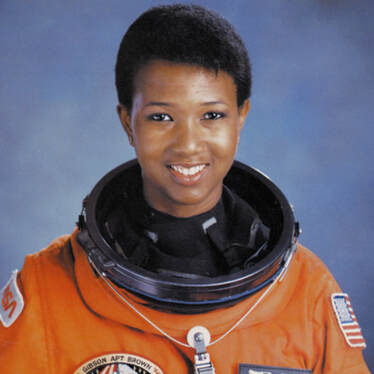 Mae Jemison, Wikimedia Commons
Mae Jemison, Wikimedia Commons
Because of the challenge set by Kennedy, Women were nowhere near the astronaut corps and therefore NASA had to work with the pilots they had—all men. But! Desegregation laws and Title IX in the 60s and 70s finally gave women greater access to space. In 1983, Sally Ride became the first American woman in space. Ride was followed by other women, including Mae Jemison, who in 1992, became the first Black woman to go to space.
In retrospect, an irony of the Cold War is that the two feuding superpowers often proclaimed competitively to care about many social issues--including women’s rights. In reality, neither country did much for their underserved populations. The Eastern Block championed the world’s workers while treating their own citizens like slaves. The United States campaigned for political freedoms abroad while systematically and horribly oppressing or Black and native communities within their borders.
The 1975 UN World Conference on Women in Beijing however, did result in 189 countries unanimously adopting an agenda for women’s empowerment and was considered the key global policy document on gender equality. Today global women’s rights is considered the greatest human rights issue of our time.
Conclusion:
By the end of this era, so much remained in question. How would women domestically use this international dialog to demand better rights domestically? Would the equal pay found in the armed forces spread to other parts of the economy?
In retrospect, an irony of the Cold War is that the two feuding superpowers often proclaimed competitively to care about many social issues--including women’s rights. In reality, neither country did much for their underserved populations. The Eastern Block championed the world’s workers while treating their own citizens like slaves. The United States campaigned for political freedoms abroad while systematically and horribly oppressing or Black and native communities within their borders.
The 1975 UN World Conference on Women in Beijing however, did result in 189 countries unanimously adopting an agenda for women’s empowerment and was considered the key global policy document on gender equality. Today global women’s rights is considered the greatest human rights issue of our time.
Conclusion:
By the end of this era, so much remained in question. How would women domestically use this international dialog to demand better rights domestically? Would the equal pay found in the armed forces spread to other parts of the economy?
Draw your own conclusions
|
Learn how to teach with inquiry.
Many of these lesson plans were sponsored in part by the Library of Congress Teaching with Primary Sources Eastern Region Program, coordinated by Waynesburg University, the History and Social Studies Education Faculty at Plymouth State University, and the Patrons of the Remedial Herstory Project. |
Lesson Plans from Other Organizations
- The National Women's History Museum has lesson plans on women's history.
- The Guilder Lehrman Institute for American History has lesson plans on women's history.
- The NY Historical Society has articles and classroom activities for teaching women's history.
- Unladylike 2020, in partnership with PBS, has primary sources to explore with students and outstanding videos on women from the Progressive era.
- The Roy Rosenzweig Center for History and New Media has produced recommendations for teaching women's history with primary sources and provided a collection of sources for world history. Check them out!
- The Stanford History Education Group has a number of lesson plans about women in US History.
Period Specific Lesson Plans from Other Organizations
- Women in the 1950s:
- Stanford History Education Group: The happy housewife is a common image of the 1950s. The lives of most women at this time, however, did not resemble this image because of economic and racial barriers. For those who were housewives, was this ideal a fulfilling reality? In this lesson plan, students consider economic and social conditions in the 1950s and question the happy housewife stereotype.
- Gilder Lehrman: This lesson explores the Feminine Mystique by Betty Friedan and asks What roles were women expected to play during the 1950s?
- Unladylike: Learn how Louise Arner Boyd defied expectations and gender roles to become a world famous Arctic explorer in this video from Unladylike2020. Boyd mapped unexplored regions of Greenland, studied and photographed topography, sea ice, glacial features, land formations and ocean depths, and made dozens of botanical discoveries. One of her innovations was the use of a heavy aerial mapping camera to document the glacial landscape at ground level, which served as the basis for new and more detailed maps of the region. Her photographs of glaciers provide critical information to climate change researchers today. Using video, discussion questions, vocabulary, and classroom activities, students learn about Boyd's contributions to science, geography, and our collective imagination about exploring new worlds.
- Eleanor Roosevelt:
- Gilder Lehrman: Students will be asked to read and analyze primary and secondary sources about Eleanor Roosevelt and the work she did to support social justice issues both in the United States and around the world. They will look at the role of first lady and see how Mrs. Roosevelt expanded that role to influence the political, social, and economic issues of the twentieth century. Students will increase their literacy skills as outlined in the Common Core Standards as they explore the social justice actions taken by Eleanor Roosevelt, which at times changed the course of world events.
- Edcitement: This lesson asks students to explore the various roles that Eleanor Roosevelt took on, among them: First Lady, political activist for civil rights, newspaper columnist and author, and representative to the United Nations. Students will read and analyze materials written by and about Eleanor Roosevelt to understand the changing roles of women in politics. They will look at Eleanor Roosevelt's role during and after the New Deal as well as examine the lives and works of influential women who were part of her political network. They will also examine the contributions of women in Roosevelt's network who played critical roles in shaping and administering New Deal policies.
- National Womens History Museum: The purpose of this lesson is to learn about Eleanor Roosevelt as an agent of social change as the First Lady of the United States and later as a representative to the United Nations. Moreover, students will learn how Mrs. Roosevelt used her position as the First Lady to become a champion of human rights which extended after her time in the White House. Students will read primary sources to better understand the legacy of Mrs. Roosevelt.
Military REcruitment
U.S Army Recruiting Poster: Mine Eyes Have Seen The Glory
Jes Wilhelm Schlaikjer, “Mine Eyes Have Seen the Glory,” Women’s Army Corps recruiting poster, 1944, https://gateway.uncg.edu/islandora/object/wvhp%3A3314.
Questions:
Questions:
- What kind of women did military leaders want to recruit, based on this advertisements?
- How did military leaders try to make military service attractive to women?
Women’s Army Corps Recruiting Pamphlet, 1962: “Somebody Special”
Food Service
Feeding the forces; food chemistry and refrigeration; menu analysis, kitchen management or cooking on a great, big scale.
Machine Accounting
Running the fabulous machines that compute, tubulate and keep track of activities throughout the Army.
Information
Keeping the Armed Forces and the public up-to-date on latest developments; perfect job for writers, editors, newscasters.
Somebody Special brochure, 1962, Department of the Army Materials, Box 6. Files of the President’s Commission on Equal Opportunity in the Armed Forces, Lyndon B. Johnson Presidential Library.
Questions:
Feeding the forces; food chemistry and refrigeration; menu analysis, kitchen management or cooking on a great, big scale.
Machine Accounting
Running the fabulous machines that compute, tubulate and keep track of activities throughout the Army.
Information
Keeping the Armed Forces and the public up-to-date on latest developments; perfect job for writers, editors, newscasters.
Somebody Special brochure, 1962, Department of the Army Materials, Box 6. Files of the President’s Commission on Equal Opportunity in the Armed Forces, Lyndon B. Johnson Presidential Library.
Questions:
- What kind of women did military leaders want to recruit, based on this advertisements?
- How did military leaders try to make military service attractive to women?
Army Recruiting Advertisement, 1979: “Some of Our Best Men Are Women”
SOME OF OUR BEST MEN ARE WOMEN.
If there's one place where opportunity is genuinely equal, it's in the army. Because in the army, people get assignments based on ability. And they get ahead the same way.
With few exceptions (mainly in Combat Specialties), Women have the same skill training programs to choose from as men. And the same opportunities for promotion.
If you've always wanted to drive a truck, or be a Carpenter and drive nails, no one will stand in your way.
On the other hand, if you've always wanted to learn how to cook. Or type. Or take dictation, well, you can do that, too. If you're willing to compete with men.
But whatever you decide to do in the army, remember, everyone is judged on ability and how hard one works. Isn't that the way it should be?
For more information about the hundreds of equal opportunities in today's Army, send one of the postcards, or call toll free: 800-431-1234. In New York, call 800-942-1990.
JOIN THE PEOPLE WHO’VE JOINED THE ARMY.
“Some of Our Best Men Are Women,” United States Army, 1979, https://ids.si.edu/ids/deliveryService?id=NMAH-AC0059-0000040.
Questions:
If there's one place where opportunity is genuinely equal, it's in the army. Because in the army, people get assignments based on ability. And they get ahead the same way.
With few exceptions (mainly in Combat Specialties), Women have the same skill training programs to choose from as men. And the same opportunities for promotion.
If you've always wanted to drive a truck, or be a Carpenter and drive nails, no one will stand in your way.
On the other hand, if you've always wanted to learn how to cook. Or type. Or take dictation, well, you can do that, too. If you're willing to compete with men.
But whatever you decide to do in the army, remember, everyone is judged on ability and how hard one works. Isn't that the way it should be?
For more information about the hundreds of equal opportunities in today's Army, send one of the postcards, or call toll free: 800-431-1234. In New York, call 800-942-1990.
JOIN THE PEOPLE WHO’VE JOINED THE ARMY.
“Some of Our Best Men Are Women,” United States Army, 1979, https://ids.si.edu/ids/deliveryService?id=NMAH-AC0059-0000040.
Questions:
- What kind of women did military leaders want to recruit, based on this advertisements?
- How did military leaders try to make military service attractive to women?
Women and Communisim
Weng Yizhi: Support Of Our Peasant Brothers
Weng Yizhi. We Are Grateful for the Support of Our Peasant Brothers for Ensuring Our Production! March 1956. 77 x 53 cm. https://chineseposters.net/posters/e15-379.
Translation from Google: "We are proud to participate in the national industrialization construction"
Question for Analysis
Translation from Google: "We are proud to participate in the national industrialization construction"
Question for Analysis
- Based on the illustration above, what message did the Chinese Communist Party (CCP) aim to send through their revolutionary posters?
Wendy Z Goldman: Glory To The Mother Heroine!
Goldman, Wendy Z. Women, the State and Revolution: Soviet Family Policy and Social Life, 1917–1936. Cambridge Russian, Soviet and Post-Soviet Studies. Cambridge: Cambridge University Press, 1993. doi:10.1017/CBO9780511665158.
Translation from Google: Glory to the mother heroine!
Question for Analysis
1. Based on the illustration above, what message was the USSR sending to women?
Translation from Google: Glory to the mother heroine!
Question for Analysis
1. Based on the illustration above, what message was the USSR sending to women?
For Communist Enlightenment: Excerpt
In the Soviet Union, the rights of mothers and children are strictly protected by the law. For example, in addition to a four month maternity leave, every working mother has the right to take breaks during work for nursing until the infant reaches the age of nine months. But it seems that the administration of school 130 in the Soviet district of Moscow considers that this rule does not apply to its school.
I have worked as a teacher for nine years, and am in my first year at school 130. Returning from maternity leave, I placed my infant in a nursery school. At first, I was able to nurse him regularly, every three hours. But because I could not nurse my infant during the break between classes (20 minutes), I was always late by 10-15 minutes.
These minutes of tardiness were not absences, because I have the right to an additional half-hour besides these 20 minutes for nursing my infant. But the head of instruction and the school director, after repeated warnings, have ordered me to either stop nursing my infant or quit working in the school, because they consider that the class (42 pupils) cannot and should not be left without a teacher for even a minute.
I completely agree with the orders of the head of instruction and the school director that pupils should not be left without a leader for even the shortest amount of time. But it does not follow from this that I, as a teacher-mother, am not able to lead the children in lessons.
This unequal battle has resulted in the victory of the school administration. Despite the orders of a doctors, I had to stop nursing my infant and switch to artificial food, which quickly had a negative effect on the child’s health.
I consider that the approach to me taken by the head of instruction and the school director demonstrates an unwillingness to let a teacher-mother have normal conditions for bringing up a healthy infant. It is possible to find a solution to this situation that does not harm the children and does not violate Soviet law by providing a substitute during this break or by drafting a schedule so that the pupils have another teacher after three hours. I love the work of teaching and do not want to give it up because of this temporary condition. In the current situation, I demand only that the administration of school 130 provide a little flexibility and human sympathy, so that I can continue working and bringing up my infant normally.
For Communist Enlightenment. ‘School No. 130 Follows Its Own Law’, 6 February 1937. https://chnm.gmu.edu/wwh/modules/lesson11/pdfs/primarysourcepacket.pdf.
Questions for Analysis
I have worked as a teacher for nine years, and am in my first year at school 130. Returning from maternity leave, I placed my infant in a nursery school. At first, I was able to nurse him regularly, every three hours. But because I could not nurse my infant during the break between classes (20 minutes), I was always late by 10-15 minutes.
These minutes of tardiness were not absences, because I have the right to an additional half-hour besides these 20 minutes for nursing my infant. But the head of instruction and the school director, after repeated warnings, have ordered me to either stop nursing my infant or quit working in the school, because they consider that the class (42 pupils) cannot and should not be left without a teacher for even a minute.
I completely agree with the orders of the head of instruction and the school director that pupils should not be left without a leader for even the shortest amount of time. But it does not follow from this that I, as a teacher-mother, am not able to lead the children in lessons.
This unequal battle has resulted in the victory of the school administration. Despite the orders of a doctors, I had to stop nursing my infant and switch to artificial food, which quickly had a negative effect on the child’s health.
I consider that the approach to me taken by the head of instruction and the school director demonstrates an unwillingness to let a teacher-mother have normal conditions for bringing up a healthy infant. It is possible to find a solution to this situation that does not harm the children and does not violate Soviet law by providing a substitute during this break or by drafting a schedule so that the pupils have another teacher after three hours. I love the work of teaching and do not want to give it up because of this temporary condition. In the current situation, I demand only that the administration of school 130 provide a little flexibility and human sympathy, so that I can continue working and bringing up my infant normally.
For Communist Enlightenment. ‘School No. 130 Follows Its Own Law’, 6 February 1937. https://chnm.gmu.edu/wwh/modules/lesson11/pdfs/primarysourcepacket.pdf.
Questions for Analysis
- What problems did the article outline that the teacher had to go through?
Pravada Vostoka: Defending the Rights of a Soviet Woman
In the collective farm “Communism,” in the Kokandskii distrct [Uzbek SSR], a determined struggle between Milidzhan Gafurovyi and his wife Rakhmalia-bibi Rustamova has been going on for the last few years. Rustamova threw off her veil, eliminated her illiteracy, works like a Stakhanovite in the collective farm, and was elected to serve as a brigade leader. With all his strength, Gafurov obstructed the political development of his wife by persecuting her and more than once threatening to kill her.
As an activist and public organizer, Rustmova was nominated and actively participated as a member of the electoral commission for the elections to the Supreme Soviet of the USSR. Gafurov began to persecute his wife even more strongly, and forced her to leave the collective farm and stop her work in the electoral commission.
Realizing his powerlessness to force his wife to submit to his influence, Gafurov decided to commit a terrorist act. The first time, he tried to kill his wife at night in their apartment, but Rustamova saved herself by running away. The second time, during the drying of the cotton crop, Gafurov again attacked his wife with a knife. This time, she was saved by the intervention of other collective farmers.
The third time, December 12, 1937, on the election day for the Supreme Soviet of the USSR, when Rustamova as a member of the electoral commission and busy with work on the elections, Gafurov forced his way into the village soviet and demanded that Rustomova immediately quit everything and return home. Rustamova refused and went into the electoral commission’s room. Following after her, Gafurov attacked his wife with a knife, but was restrained.
This matter was investigated on June 11-12 of this year [1938] in the village of ArzykTepe, in the presence of the collective farm’s Military tribunal SAVO composed of acting military jurist second rank comrade Pensin and court members lieutenants Anisenko and Spichkin.
The court determined that Gafurov is a descendant of a kulak-bai family, was a merchant, and has for the last few years lived on the income of his wife. The court sentenced Gafurov to be executed. The collective farm members attending the trial greeted the sentence with expressions of satisfaction.
Pravada Vostoka. ‘Defending the Rights of a Soviet Woman’, 22 June 1938.
Questions for Analysis
As an activist and public organizer, Rustmova was nominated and actively participated as a member of the electoral commission for the elections to the Supreme Soviet of the USSR. Gafurov began to persecute his wife even more strongly, and forced her to leave the collective farm and stop her work in the electoral commission.
Realizing his powerlessness to force his wife to submit to his influence, Gafurov decided to commit a terrorist act. The first time, he tried to kill his wife at night in their apartment, but Rustamova saved herself by running away. The second time, during the drying of the cotton crop, Gafurov again attacked his wife with a knife. This time, she was saved by the intervention of other collective farmers.
The third time, December 12, 1937, on the election day for the Supreme Soviet of the USSR, when Rustamova as a member of the electoral commission and busy with work on the elections, Gafurov forced his way into the village soviet and demanded that Rustomova immediately quit everything and return home. Rustamova refused and went into the electoral commission’s room. Following after her, Gafurov attacked his wife with a knife, but was restrained.
This matter was investigated on June 11-12 of this year [1938] in the village of ArzykTepe, in the presence of the collective farm’s Military tribunal SAVO composed of acting military jurist second rank comrade Pensin and court members lieutenants Anisenko and Spichkin.
The court determined that Gafurov is a descendant of a kulak-bai family, was a merchant, and has for the last few years lived on the income of his wife. The court sentenced Gafurov to be executed. The collective farm members attending the trial greeted the sentence with expressions of satisfaction.
Pravada Vostoka. ‘Defending the Rights of a Soviet Woman’, 22 June 1938.
Questions for Analysis
- What does the newspaper articulate about how women are treated socially?
- Were women protected against discrimination?
The Cold War and Womens Rights around the World
Elaine Tyler May: Women Stayed Home in the Cold War
The latest chapter of better U.S.-Soviet relations is good news for American women. The Cold War always had a chilling effect on the momentum for women’s rights.
In the early years of the Cold War, a broad-based consensus of liberals and conservatives called for the “moral rearmament” of America. Observers had been concerned about the nation’s morals since World War II, when changes in human relations and sexual mores appeared as threatening to the American Way of Life as communism itself. No wonder, then, that Joseph McCarthy and his followers attacked “pinkos” and homosexuals with equal vigor; America could only be strong, it seemed, if men were men and women were housewives.
World War II brought women, including Rosie the Riveter, into the public arena but it also made women, especially unmarried women, suspect. Single women had enjoyed a modicum of respectability during the first four decades of the century; suddenly they were not to be trusted. Soldiers were warned that single women were sexual predators out to sap them of their money and vigor. After the war, popular movies and novels like Mickey Spillane thrillers depicted powerful women whose sexuality and economic shrewdness destroyed men in their path, or whose seductiveness tempted weak men to give atom secrets to Soviet spies.
At the same time, federal subsidies encouraged early marriage by supporting suburban developments containing thousands of inexpensive houses designed to facilitate child-rearing. Government agencies, arguing that urban centers were likely targets of nuclear attack, gained approval for new highways and decentralized industries to help spread the population into family-centered suburbs.
Most powerful of all were the child-rearing experts, social scientists and psychologists who claimed that if women did their jobs well in the home, they would raise the citizens and scientists who would guarantee America’s future security. But if they pursued careers or sexual relationships outside the home, then the nation would be filled with juvenile delinquents, degenerate men, crime and chaos.
Did women accept this ideology just because they did not want to be considered security risks? Hardly. The postwar years offered very few viable alternatives for women to achieve economic independence and professional achievement. The best route to financial security and social standing was marriage to a successful breadwinner. So women carved out a place for themselves in the domestic ideology by infusing their job with dignity and professional standards, and by having several children who would, they hoped, build a better future.
As it turned out, these women did not necessarily find fulfillment in the domestic role they embraced. Their own baby-boom children grew up to challenge the family ideology as well as the Cold War assumptions of their parents. Young people returned, instead, to trends their grandparents had once furthered: fewer children, more single individuals and grass-roots political activism against the status quo. As young Americans in the ‘60s and ‘70s shook loose from the imperatives of the Cold War, they also rejected the sexual taboos of the past, opposed the nation’s foreign policy and breathed new life into the feminist movement. The years of detente in the 1970s brought national affirmative-action policies, legalized abortion, pay-equity measures--and a crowd of women entering male-dominated occupations.
If the Reagan era is coming to an end along with the Cold War, opportunities for women are likely to continue to expand. As the nation’s leaders respond to Mikhail S. Gorbachev’s detente initiatives, the forces of militarism and anti-feminism at home also lose their power to influence policy. Hard-line conservatives are unable to curtail reproductive choice, while efforts to provide aid to the Contras continue to be contested in Congress. Perhaps the most telling sign that Cold War values no longer dominate domestic politics can be found in the current election campaign, as both major political parties try to out-do each other on the issue of child-care. The gender gap has finally replaced the missile gap as a rallying cry for politicians seeking to win elections.
Elaine Tyler May. ‘Women Stayed Home in the Cold War’. Los Angeles Times, 18 September 1988. https://www.latimes.com/archives/la-xpm-1988-09-18-op-3106-story.html.
Questions:
In the early years of the Cold War, a broad-based consensus of liberals and conservatives called for the “moral rearmament” of America. Observers had been concerned about the nation’s morals since World War II, when changes in human relations and sexual mores appeared as threatening to the American Way of Life as communism itself. No wonder, then, that Joseph McCarthy and his followers attacked “pinkos” and homosexuals with equal vigor; America could only be strong, it seemed, if men were men and women were housewives.
World War II brought women, including Rosie the Riveter, into the public arena but it also made women, especially unmarried women, suspect. Single women had enjoyed a modicum of respectability during the first four decades of the century; suddenly they were not to be trusted. Soldiers were warned that single women were sexual predators out to sap them of their money and vigor. After the war, popular movies and novels like Mickey Spillane thrillers depicted powerful women whose sexuality and economic shrewdness destroyed men in their path, or whose seductiveness tempted weak men to give atom secrets to Soviet spies.
At the same time, federal subsidies encouraged early marriage by supporting suburban developments containing thousands of inexpensive houses designed to facilitate child-rearing. Government agencies, arguing that urban centers were likely targets of nuclear attack, gained approval for new highways and decentralized industries to help spread the population into family-centered suburbs.
Most powerful of all were the child-rearing experts, social scientists and psychologists who claimed that if women did their jobs well in the home, they would raise the citizens and scientists who would guarantee America’s future security. But if they pursued careers or sexual relationships outside the home, then the nation would be filled with juvenile delinquents, degenerate men, crime and chaos.
Did women accept this ideology just because they did not want to be considered security risks? Hardly. The postwar years offered very few viable alternatives for women to achieve economic independence and professional achievement. The best route to financial security and social standing was marriage to a successful breadwinner. So women carved out a place for themselves in the domestic ideology by infusing their job with dignity and professional standards, and by having several children who would, they hoped, build a better future.
As it turned out, these women did not necessarily find fulfillment in the domestic role they embraced. Their own baby-boom children grew up to challenge the family ideology as well as the Cold War assumptions of their parents. Young people returned, instead, to trends their grandparents had once furthered: fewer children, more single individuals and grass-roots political activism against the status quo. As young Americans in the ‘60s and ‘70s shook loose from the imperatives of the Cold War, they also rejected the sexual taboos of the past, opposed the nation’s foreign policy and breathed new life into the feminist movement. The years of detente in the 1970s brought national affirmative-action policies, legalized abortion, pay-equity measures--and a crowd of women entering male-dominated occupations.
If the Reagan era is coming to an end along with the Cold War, opportunities for women are likely to continue to expand. As the nation’s leaders respond to Mikhail S. Gorbachev’s detente initiatives, the forces of militarism and anti-feminism at home also lose their power to influence policy. Hard-line conservatives are unable to curtail reproductive choice, while efforts to provide aid to the Contras continue to be contested in Congress. Perhaps the most telling sign that Cold War values no longer dominate domestic politics can be found in the current election campaign, as both major political parties try to out-do each other on the issue of child-care. The gender gap has finally replaced the missile gap as a rallying cry for politicians seeking to win elections.
Elaine Tyler May. ‘Women Stayed Home in the Cold War’. Los Angeles Times, 18 September 1988. https://www.latimes.com/archives/la-xpm-1988-09-18-op-3106-story.html.
Questions:
- What does this article outline to be one of the main deterrents of women’s rights in the US?
- Why were politicians so concerned with women’s place in society during the Cold War?
- What policies were used to incentivize “moral rearmament”?
- What was the reaction to these policies put in place? What were the aftereffects of these policies?
A Report on the state of women’s issues in Post-Communist Transition
In the countries of post-communism transition there are many similarities in the situation of women, despite the fact that these countries have different historical, economic and religious backgrounds and that their totalitarian regimes were also radically different.
The states of the so-called socialist (communist) systems, using their political and social power and propaganda, managed to cover up the depths of the inequalities in gendered opportunities. So, after the transformation, the illusion still remained that equal opportunities for women had already been established. At the same time, society was not prepared for the dramatic changes that occurred in the differences of opportunities (according to age, region, education, etc.)
During the transformation of the economy, women fell out of the labour market in great numbers to find themselves in the household, which did not provide any income for them, or in early retirement. Women's political representation radically decreased, compared to the "statist feminist" era, when their representation was regulated by quota. In the last decade, however, their proportion has increased again, especially at local levels. Non-profit organisations, representing the interests of women, were not strong enough to break through the political walls and realise their interests and programmes in political life, or to give voice to their values in public discourse, despite their strong activities in certain countries.
Therefore, the Parliamentary Assembly recommends to the governments of Central and Eastern Europe a number of measures aimed at improving legal norms on gender equality, the economic status of women in society, as well as their health and social protection.
Magdolna Kósá-Kovács. ‘The Situation of Women in the Countries of Post-Communism Transition’, 9 June 2004. https://assembly.coe.int/nw/xml/XRef/X2H-Xref-ViewHTML.asp?FileID=10366&lang=EN.
Questions:
The states of the so-called socialist (communist) systems, using their political and social power and propaganda, managed to cover up the depths of the inequalities in gendered opportunities. So, after the transformation, the illusion still remained that equal opportunities for women had already been established. At the same time, society was not prepared for the dramatic changes that occurred in the differences of opportunities (according to age, region, education, etc.)
During the transformation of the economy, women fell out of the labour market in great numbers to find themselves in the household, which did not provide any income for them, or in early retirement. Women's political representation radically decreased, compared to the "statist feminist" era, when their representation was regulated by quota. In the last decade, however, their proportion has increased again, especially at local levels. Non-profit organisations, representing the interests of women, were not strong enough to break through the political walls and realise their interests and programmes in political life, or to give voice to their values in public discourse, despite their strong activities in certain countries.
Therefore, the Parliamentary Assembly recommends to the governments of Central and Eastern Europe a number of measures aimed at improving legal norms on gender equality, the economic status of women in society, as well as their health and social protection.
Magdolna Kósá-Kovács. ‘The Situation of Women in the Countries of Post-Communism Transition’, 9 June 2004. https://assembly.coe.int/nw/xml/XRef/X2H-Xref-ViewHTML.asp?FileID=10366&lang=EN.
Questions:
- According to the report, what is the state of women’s issues?
- How have women’s rights transformed since the end of communism?
- What are some suggestions the report makes to improve the situation in post-communist countries?
Slavenka Drakulic- Speech at the Institute for Human Sciences
Emancipation from above – as I call it – was the main difference between the lives of women under communism and those of women in Western democracies. Emancipatory law was built into the communist legal system, guaranteeing to women all the basic rights –from voting to property ownership, from education to divorce, from equal pay for equal work to the right to control their bodies. But, as Ulf Brunnbauer writes in his 2000 essay From equality without democracy to democracy without equality?:
“Proclamations of gender equality never corresponded to social reality. Patriarchal values and structures were not eradicated, but the ‘family patriarch’ was replaced by the authoritarian state – emancipation was not an end in itself, but an instrument for wider political goals, as defined by the party.”
The formal equality of women in the communist world was observed mostly in public life and in institutions. The private sphere, on the other hand, was dominated by male chauvinism. This meant a lot of unreported domestic violence, for example. It also meant that men usually had no obligations at home, which left women with less time for themselves. It was not only the lack of freedom – and time – that prevented women fighting for changes but, more importantly, a lack of belief that change was necessary. Someone else up there was in charge of thinking about that for you. And because change came from the powers that be, women were made to believe there was no need for change or room for improvement.
If, however, there were any minor problems resulting from women’s specific needs, then there were women’s organizations that were supposed to take care of them. However, these were only instruments of communist party power and were concerned less with women and their needs and more with ideology. Feminist consciousness didn’t exist. Since women were emancipated, there was no need for a discussion about women’s rights, so the argument went. It was as if women lived in an ideal world, but were not fully aware of it, or failed to appreciate the fact. And those who tried to enlighten them about the real situation were seen as “suspicious elements”. Women who attempted to publically discuss feminism in Yugoslavia in the 1980s were accused by the authorities of “importing foreign, bourgeois ideas”.
At that time, Eastern European women speaking publicly would typically introduce themselves by saying “I am not a feminist, but…” Of course, they were afraid of being ridiculed. Today, one reads that numerous feminist NGOs were formed in Eastern Europe shortly after 1989, but that was not at all my experience. During my travels for the magazine Ms., trying to find feminists was like looking for a needle in a haystack. There were good reasons for this. For a long time, even after 1989, women in former communist countries did not want to be identified as feminists, even if they were. If anything, to be a feminist was considered to be a kind of a dissident. Prejudices against Western, and especially American feminists were spread by the press; not only were they men-haters too ugly to find a husband, but they were also burning bras!
The post-communist revival of conservative values, nationalism and religion is having an effect on the behaviour of women not only in my small country. Their passivity and disinterest is not hard to understand. When everything around you is changing so dramatically, then you tend not to embrace the new circumstances, but to cling to habits, values and ideas that were there before –before communism. Unfortunately, this means a radical backlash, the return to a feudal value system. After the collapse of communism, most countries in the region experienced a renaissance of nationalism and religion – precisely the two things that were suppressed under communism. It was all that remained from the pre-communist past. Patriarchy, which seemed to have disappeared, reared its head again, looking healthier than ever. Patriarchy after Patriarchy – as Karl Kaser wrote. But is it only temporary?
So, for women in Eastern Europe, the freedom regained in 1989 has brought unexpected limitations on economic, social and even reproductive rights. Women were hit by cuts in public spending and seen as an inferior category of employee, causing mass female unemployment. Poverty was feminized. With the political focus on economic transformation and the building of democratic structures, women’s rights weren’t a top priority. As a result, fewer and fewer women worked (although we now know that many, between 30 to 50 %, were part of the informal economy). More and more stayed at home, avoiding politics and public life, being persuaded that this was the right thing to do.
Drakulic, Slavenka., “How Women Survived Post-Communism (and didn’t Laugh)” (speech, Vienna, Austria, May 29 2015), Institute for Human Sciences. https://www.iwm.at/transit-online/how-women-survived-post-communism-and-didnt-laugh.
Questions:
- What does Slavenka Drakulic claim is the main difference between the lives of women in western societies and communist ones?
- What were some key similarities and differences between attitudes towards women’s issues in western democratic societies and in eastern european societies at the time?
- According to Drakulic, why was there a revival in conservative values after communism?
- What does this speech say about the environment towards women’s rights in eastern europe after communism?
The war in Vietnam
Liberation of Women: Students for a Democratic Society
In 1967 women convened at the National Convention for the Students for a Democratic Society. Members wrote the following excerpt from their position statement. Students for a Democratic Society was a national student activist organization during the 1960s, and was one of the principal representations of the New Left.
As we analyze the position of women in capitalist society and especially in the United States we find that women are in a colonial relationship to men and we recognize ourselves as part of the third world.
“Liberation of Women,” New Left Notes, July 10, 1967. In Cyrana B. Wyker. “Women in Wargasm: The Politics of Womenís Liberation in the Weather Underground Organization.” University of South Florida Scholar Commons. April 26, 2009. https://digitalcommons.usf.edu/cgi/viewcontent.cgi?article=1092&context=etd.
Guiding Questions:
As we analyze the position of women in capitalist society and especially in the United States we find that women are in a colonial relationship to men and we recognize ourselves as part of the third world.
“Liberation of Women,” New Left Notes, July 10, 1967. In Cyrana B. Wyker. “Women in Wargasm: The Politics of Womenís Liberation in the Weather Underground Organization.” University of South Florida Scholar Commons. April 26, 2009. https://digitalcommons.usf.edu/cgi/viewcontent.cgi?article=1092&context=etd.
Guiding Questions:
- Describe the authors of this position statement. What are their demographics likely to be? Consider age, gender, class, etc.
- With whom do these authors identify?
- Why might this identity be strange?
Diane Nash: Journey to North Vietnam
Diane Nash was a civil rights activist who was active in the sit-in movement. She traveled to Vietnam to examine the impact of the war.
We left New York on the evening of December 15, 1966. We would fly to Paris, Moscow, Peking, Na Ning (China) and then to Hanoi. There were four of us.
All four of us are American citizens and all four of us oppose the United States fighting this war. We did not represent a group or any organization. We were four individuals. Each of us had her own particular opinions about the issues and each had her own reasons for going. In fact, I might say that we disagreed on practically every other subject from child care and men, to politics and nonviolence. The only issue that I can remember all of us agreeing upon during the entire month we were together was that we were all against the war.
Let me take this opportunity to make it very clear that any statement I make applies only to me. I cannot speak for any of the other three ladies.
I am against the war because I am against using murder as a solution to human problems.
Later that morning we visited Phuc Tan Street which is in the central district of Hanoi. There was extensive damage which de- stroyed about 300 dwelling houses~ This is one of the most densely populated areas of Hanoi. We witnessed this damage and the fact that it was a densely populated area in the center of Hanoi with our own eyes. Here a woman eight months pregnant had her unborn child blown out of her body. The bodies of the mother and the un- born child were recovered some distance apart from each other. While we were looking at the spectacle we saw lying on the ground a section of human jawbone with teeth. Dishes, shoes, children's toys and charred household items were scattered everywhere. Another woman pregnant and obviously ready to deliver any day told us of having lost her son, 7 years old, and her daughter, 2V2 years old.
We then left and visited another bombed section in Hanoi, Nguyen Thiep Street. Again this was a densely populated street in the center of Hanoi. Hanoi is divided into four districts. Bombing had taken place in all four.
That evening we visited Hanoi hospital. We met with the doctors and staff. Dr. Fut gave a report of attacks by the United States on the medical facilities of North Vietnam.
His main points were (quoting from his remarks on that occasion) :
"The U.S. has good reconnaissance and has deliberately and systematically attacked medical institutions in North Vietnam in order to paralyze the medical proceedings of the country and to de- moralize the people.”
Bevel, Diane Nash. "Journey to North Vietnam." (Spring 1967). Freedomways, 7(2), 118-128.
Questions:
We left New York on the evening of December 15, 1966. We would fly to Paris, Moscow, Peking, Na Ning (China) and then to Hanoi. There were four of us.
All four of us are American citizens and all four of us oppose the United States fighting this war. We did not represent a group or any organization. We were four individuals. Each of us had her own particular opinions about the issues and each had her own reasons for going. In fact, I might say that we disagreed on practically every other subject from child care and men, to politics and nonviolence. The only issue that I can remember all of us agreeing upon during the entire month we were together was that we were all against the war.
Let me take this opportunity to make it very clear that any statement I make applies only to me. I cannot speak for any of the other three ladies.
I am against the war because I am against using murder as a solution to human problems.
Later that morning we visited Phuc Tan Street which is in the central district of Hanoi. There was extensive damage which de- stroyed about 300 dwelling houses~ This is one of the most densely populated areas of Hanoi. We witnessed this damage and the fact that it was a densely populated area in the center of Hanoi with our own eyes. Here a woman eight months pregnant had her unborn child blown out of her body. The bodies of the mother and the un- born child were recovered some distance apart from each other. While we were looking at the spectacle we saw lying on the ground a section of human jawbone with teeth. Dishes, shoes, children's toys and charred household items were scattered everywhere. Another woman pregnant and obviously ready to deliver any day told us of having lost her son, 7 years old, and her daughter, 2V2 years old.
We then left and visited another bombed section in Hanoi, Nguyen Thiep Street. Again this was a densely populated street in the center of Hanoi. Hanoi is divided into four districts. Bombing had taken place in all four.
That evening we visited Hanoi hospital. We met with the doctors and staff. Dr. Fut gave a report of attacks by the United States on the medical facilities of North Vietnam.
His main points were (quoting from his remarks on that occasion) :
"The U.S. has good reconnaissance and has deliberately and systematically attacked medical institutions in North Vietnam in order to paralyze the medical proceedings of the country and to de- moralize the people.”
Bevel, Diane Nash. "Journey to North Vietnam." (Spring 1967). Freedomways, 7(2), 118-128.
Questions:
- Who was Nash and how might her background impact her view of this war against the Viet-Cong?
- Why did Nash oppose the war?
- What strategy did she use to persuade others to her perspective?
Dorothy Marder: Women Strike for Peace Movement (1961-1975)
“Women Strike for Peace, 1961-1975.” Dorothy Marder Women strike for peace exhibit. Swarthmore College Peace Collection. Accessed November 15, 2022. https://www.swarthmore.edu/library/peace/Exhibits/Dorothy%20Marder/MarderExhibit1A_files/MarderExhibit1A.html.
Questions:
- What was Women Strike for Peace? And what did they oppose?
- Based on these images, why did these women oppose the war in Vietnam?
Numerous: American Public Opinion and the War in Vietnam
sex
Converse and Schuman's study of public attitudes towards the war in Vietnam pointed out that "women have traditionally been unenthusiastic about war involve- ment, and the largest sex differences in responses emerge when policies involving strong military initiatives are at stake."33 Throughout the polls measuring public response to the war, females consistently exhibit more dovish attitudes than men which tends to discredit the theory of the "greater burden," as did the data for age. The annual mean support figures for the war (as measured by negative responses to the Gallup mistake question) reflect this difference (see Table 5).84 It is in- teresting to note that as the war dragged on, the difference between men and women's opinions narrowed somewhat. This pattern also emerges when one considers views of escalation (see Table 6) - at first, a majority of the men questioned by the SRC favored this alternative, but less than two out of every five women did. After a few years of war, this al-ternative appeared less appealing to both sexes, and the difference between them began to decline - by 1970 the sexes were apart by ten percentage points. On the withdrawal side, however, the differences between men and women not only re- mained, but grew. Together, these figures suggest that men and women evaluated the war in Vietnam differently throughout its course, with men more hawkish and women more dovish.
Race
Probably the most widely noted demographic aspect of public opinion about the war in Vietnam was the opposition of American blacks. By any measure, blacks were substantially more opposed to U.S. intervention in Vietnam than whites. In local referenda concerning the war held in 1966, 1967, and 1968, black precincts were likely to oppose the war more strongly than white precincts: "... race was associated with opposition to the war in Madison and Cambridge, where black voters comprised a small segment of the community, and in San Francisco, which contained a sizeable black population."35 The SRC policy alternative question also demonstrates this pattern quite clearly (see Table 7). Blacks always favored with- drawal more than whites, and by increasing margins as the war dragged on. More- over, blacks were consistently more unfavorable towards escalation when compared to whites. Ratios of two and three to one were the norm between the races on the question of escalation. How can these patterns be explained? Generally, black citizens have had fewer positive experiences with their government than white citizens. A kind of generic mistrust and suspicion of white politicians and their works (which white voters were to acquire only after a number of disillusioning incidents) may provide part of the explanation for black resistance to the war in Vietnam. In addition, it is possible that many blacks believed claims that a disproportionate number of combat troops in Vietnam were black (and other minority group members), and that a disproportionate percentage of the deaths in the war were sustained by non- whites. As far as public opinion is concerned, it did not matter whether such claims were true or not; if enough non-white citizens believed them, such belief would probably appear in the form of reduced support and increased opposition to the war among such respondents.7 Finally, the war in Vietnam coincided with a period of quite inflamed rhetoric in the black community which sometimes branded the war in Vietnam as racist. Whether this charge was correct or not, it may have increased opposition to the war among minority groups.
Lunch, William L., and Peter W. Sperlich. “American Public Opinion and the War in Vietnam.” The Western Political Quarterly 32, no. 1 (1979): 21–44. https://doi.org/10.2307/447561.
Questions:
Lunch, William L., and Peter W. Sperlich. “American Public Opinion and the War in Vietnam.” The Western Political Quarterly 32, no. 1 (1979): 21–44. https://doi.org/10.2307/447561.
Questions:
- Based on this information from Gallup Polls in the period, were women more or less likely to support the war in Vietnam than men?
- What other characteristics were strong indicators of their support for the war?
Vietnam Women's Memorial
By 1967, most all military nurses who volunteered to go to Vietnam did so shortly after graduation. These women were the youngest group of medical personnel ever to serve in war time.
Because of the guerilla tactics of Vietnam, many women were in the midst of the conflict. There was no front, no such thing as "safe behind our lines." Many were wounded; most spent time in bunkers during attacks. The names of the eight military women who died in Vietnam are listed on the "Wall."
Medical personnel dealt with extraordinary injuries inflicted by enemy weapons specifically designed to mutilate and maim. During massive casualty situations, nurses often worked around the clock, conducted triage, assisted with emergency tracheotomies and amputations, debrided wounds and inserted chest tubes so surgeons could get to the next critical patient. Over 58,000 soldiers died in Vietnam; 350,000 were wounded.
It is estimated that approximately 265,000 military women served their country during the Vietnam war all over the world in a variety of occupations. Thousands of women served in Japan, Guam, the Philippines, Hawaii, and other stateside hospitals caring for the wounded and dying who had been stabilized and flown out of the war zone. Many Navy women were stationed aboard the USS Repose and the USS Sanctuary, hospital ships stationed off the coast of South Vietnam. Air Force nurses served both "in country" and on air evacuation missions.
An unknown number of civilian women also served in Vietnam as news correspondents and workers for the Red Cross, the USO, the American Friends Service Committee, Catholic Relief Services and other humanitarian organizations. Like their military counterparts, many of these women were wounded in the crossfire. More than 50 civilian American women died in Vietnam.
Many Vietnam women veterans have never told their friends, colleagues or even loved ones about their tour of duty in Vietnam. The majority of them were only in their early 20s when they returned to a country that did not understand what they had just experienced. Although most were there to save lives, they received the same hostile treatment as the returning combat soldiers…
According to a recent Veterans Administration report, 48% of the women who served during the Vietnam conflict will suffer from some form of post-traumatic stress disorder (PTSD) during their lives. Yet, few have sought documented help for it. Many women also have suffered health problems associated with Agent Orange exposure. Some have committed suicide.
Vietnam Women’s Memorial. “Vietnam Women’s Memorial.” n.d. http://www.vietnamwomensmemorial.org/vwmf.php.
Questions:
Because of the guerilla tactics of Vietnam, many women were in the midst of the conflict. There was no front, no such thing as "safe behind our lines." Many were wounded; most spent time in bunkers during attacks. The names of the eight military women who died in Vietnam are listed on the "Wall."
Medical personnel dealt with extraordinary injuries inflicted by enemy weapons specifically designed to mutilate and maim. During massive casualty situations, nurses often worked around the clock, conducted triage, assisted with emergency tracheotomies and amputations, debrided wounds and inserted chest tubes so surgeons could get to the next critical patient. Over 58,000 soldiers died in Vietnam; 350,000 were wounded.
It is estimated that approximately 265,000 military women served their country during the Vietnam war all over the world in a variety of occupations. Thousands of women served in Japan, Guam, the Philippines, Hawaii, and other stateside hospitals caring for the wounded and dying who had been stabilized and flown out of the war zone. Many Navy women were stationed aboard the USS Repose and the USS Sanctuary, hospital ships stationed off the coast of South Vietnam. Air Force nurses served both "in country" and on air evacuation missions.
An unknown number of civilian women also served in Vietnam as news correspondents and workers for the Red Cross, the USO, the American Friends Service Committee, Catholic Relief Services and other humanitarian organizations. Like their military counterparts, many of these women were wounded in the crossfire. More than 50 civilian American women died in Vietnam.
Many Vietnam women veterans have never told their friends, colleagues or even loved ones about their tour of duty in Vietnam. The majority of them were only in their early 20s when they returned to a country that did not understand what they had just experienced. Although most were there to save lives, they received the same hostile treatment as the returning combat soldiers…
According to a recent Veterans Administration report, 48% of the women who served during the Vietnam conflict will suffer from some form of post-traumatic stress disorder (PTSD) during their lives. Yet, few have sought documented help for it. Many women also have suffered health problems associated with Agent Orange exposure. Some have committed suicide.
Vietnam Women’s Memorial. “Vietnam Women’s Memorial.” n.d. http://www.vietnamwomensmemorial.org/vwmf.php.
Questions:
- How did women support the war in Vietnam? What roles did they play?
- Based on this document, why did these women support the war?
Impact on Vietnamese WOmen
Le Browne: Her Experience in the Diem Regime
Le Lieu Browne, a Vietnamese woman educated in France and married to an American journalist, recalls her mixed feelings about her experience working for the Diem regime.
I grew up in Ben Tre in the Mekong Delta, which was reputed to be a stronghold of Communist sympathizers. The French controlled big towns while the Viet Minh controlled the countryside. When the French tried to occupy Ben Tre with their legionnaires and Moroccans and Nigerans they were brutal. But so were the Viet Minh. If they found civil servants or "pro government elements" they took them away and we never heard from them again….
About half the students in my high school were pro-Viet Minh. They organized demonstrations and strikes which constantly closed down the school. My mother worried about our education and decided to send me, along with my twin brothers, to France….
When I returned in 1959 I worked for the Ministry of Information….I worked there for three years but I wasn't happy and wanted to get out….I strongly believed in freedom and suddenly we were ordered to wear uniforms to work and go to political meetings. It sounded to me more like Communism than democracy….
After the coup against Diem, the military generals competed with one another to take power and there was one coup after another. These Vietnamese generals had no experience in administration. They were even more corrupt than Diem…It wasn't good to have generals as presidents. They gave me no hope. But the American buildup also left me skeptical. If the French who colonized our country for a century could not win our support, how could the Americans, the newcomers with a different culture and language, hope to win the war against the Communists? We seemed to return to the situation in the fifties in which the government controlled the cities and the Viet Cong controlled the countryside. Corruption and police harassment made people distrust the government and sympathize more with the Viet Cong. But still I didn't think the Viet Cong would win. I just thought that the war would go on forever.
Appy G, Christian. Interview with Le Lieu Browne.“A South Vietnamese Woman Recalls Her Experience in the Diem Regime,” SHEC: Resources for Teachers.
Questions:
I grew up in Ben Tre in the Mekong Delta, which was reputed to be a stronghold of Communist sympathizers. The French controlled big towns while the Viet Minh controlled the countryside. When the French tried to occupy Ben Tre with their legionnaires and Moroccans and Nigerans they were brutal. But so were the Viet Minh. If they found civil servants or "pro government elements" they took them away and we never heard from them again….
About half the students in my high school were pro-Viet Minh. They organized demonstrations and strikes which constantly closed down the school. My mother worried about our education and decided to send me, along with my twin brothers, to France….
When I returned in 1959 I worked for the Ministry of Information….I worked there for three years but I wasn't happy and wanted to get out….I strongly believed in freedom and suddenly we were ordered to wear uniforms to work and go to political meetings. It sounded to me more like Communism than democracy….
After the coup against Diem, the military generals competed with one another to take power and there was one coup after another. These Vietnamese generals had no experience in administration. They were even more corrupt than Diem…It wasn't good to have generals as presidents. They gave me no hope. But the American buildup also left me skeptical. If the French who colonized our country for a century could not win our support, how could the Americans, the newcomers with a different culture and language, hope to win the war against the Communists? We seemed to return to the situation in the fifties in which the government controlled the cities and the Viet Cong controlled the countryside. Corruption and police harassment made people distrust the government and sympathize more with the Viet Cong. But still I didn't think the Viet Cong would win. I just thought that the war would go on forever.
Appy G, Christian. Interview with Le Lieu Browne.“A South Vietnamese Woman Recalls Her Experience in the Diem Regime,” SHEC: Resources for Teachers.
Questions:
- What kind of source is this?
- How might her background impact her biases?
- What were her opinions about the war?
Nick Ut: Napalm Girl During Vietnam
Truong My Hoa: Her Recollection of Her Revolutionary Activities
Truong My Hoa, a Vietnamese woman from a "revolutionary tradition" and later a high-ranking member of the Communist Party, recalls her experiences as a young revolutionary and subsequent imprisonment by the South Vietnamese government.
I was born to a revolutionary family and inherited a revolutionary tradition. My hometown of Tien Giang was a revolutionary hotbed. My parents had taken part in the resistance war against the French for which both were arrested and imprisoned. My brothers and sisters and I were imprisoned during the American War. Altogether my family spent half a century in jail.
In 1954, my father regrouped to the North in compliance with the Geneva Accords. My mother remained in the South with the children, and like everybody else, she thought that general elections would be implemented two years later and the country, as well as all the families, would be reunited. However, the puppet government of Ngo Dinh Diem unilaterally carried out a bloody war, supported by American imperialists.
I began to participate in the revolution at age fifteen, in 1960, when the Saigon regime took its guillotine throughout the South to behead patriotic revolutionaries and even non-revolutionary common people. I realized in my heart that we had no alternative but to struggle against the Diem government and its henchmen. That was the only way we could achieve peace, independence, and unification. Because of Diem’s terror in the countryside, my mother took us to Saigon. There, right in the gorge of the puppet regime, I became a revolutionary. I participated in propaganda aimed at mobilizing high school and college students. We urged them to resist military conscription and the invasion of our country by American imperialists.
I was arrested on April 15, 1964. The Saigon Military Tribunal accused me of disrupting order and political stability. I was officially sentenced to eighteen months of confinement, but they kept prolonging the sentence and held me in prison for eleven years. I was released on March 7, 1975….
Over the years I underwent a lot of interrogation and torture…. Always they asked me if we were going to talk, or not, and they slandered our political loyalties. They tried to make us salute their flag and condemn Communism. They tried to make us say, 'Down with President Ho!' And, of course, they wanted to know about our revolutionary organizations and bases. But we would rather die than bow to their will.
Appy G, Christian. Interview with Truong My Hoa.“A Vietnamese Woman Recalls Her Revolutionary Activities,” SHEC: Resources for Teachers.
Questions:
I was born to a revolutionary family and inherited a revolutionary tradition. My hometown of Tien Giang was a revolutionary hotbed. My parents had taken part in the resistance war against the French for which both were arrested and imprisoned. My brothers and sisters and I were imprisoned during the American War. Altogether my family spent half a century in jail.
In 1954, my father regrouped to the North in compliance with the Geneva Accords. My mother remained in the South with the children, and like everybody else, she thought that general elections would be implemented two years later and the country, as well as all the families, would be reunited. However, the puppet government of Ngo Dinh Diem unilaterally carried out a bloody war, supported by American imperialists.
I began to participate in the revolution at age fifteen, in 1960, when the Saigon regime took its guillotine throughout the South to behead patriotic revolutionaries and even non-revolutionary common people. I realized in my heart that we had no alternative but to struggle against the Diem government and its henchmen. That was the only way we could achieve peace, independence, and unification. Because of Diem’s terror in the countryside, my mother took us to Saigon. There, right in the gorge of the puppet regime, I became a revolutionary. I participated in propaganda aimed at mobilizing high school and college students. We urged them to resist military conscription and the invasion of our country by American imperialists.
I was arrested on April 15, 1964. The Saigon Military Tribunal accused me of disrupting order and political stability. I was officially sentenced to eighteen months of confinement, but they kept prolonging the sentence and held me in prison for eleven years. I was released on March 7, 1975….
Over the years I underwent a lot of interrogation and torture…. Always they asked me if we were going to talk, or not, and they slandered our political loyalties. They tried to make us salute their flag and condemn Communism. They tried to make us say, 'Down with President Ho!' And, of course, they wanted to know about our revolutionary organizations and bases. But we would rather die than bow to their will.
Appy G, Christian. Interview with Truong My Hoa.“A Vietnamese Woman Recalls Her Revolutionary Activities,” SHEC: Resources for Teachers.
Questions:
- What kind of source is this?
- What were her opinions about the war?
Remedial Herstory Editors. "22. WOMEN AND THE COLD WAR." The Remedial Herstory Project. November 20, 2022. www.remedialherstory.com.
Primary AUTHOR: |
Dr. Barbara Tischler and Kelsie Brook Eckert
|
Primary ReviewerS: |
Dr. Jessica Frazier and Dr. Tanya Roth
|
Consulting TeamKelsie Brook Eckert, Project Director
Coordinator of Social Studies Education at Plymouth State University Dr. Barbara Tischler, Consultant Professor of History Hunter College and Columbia University Dr. Alicia Gutierrez-Romine, Consultant Assistant Professor of History at La Sierra University Jacqui Nelson, Consultant Teaching Lecturer of Military History at Plymouth State University Dr. Deanna Beachley Professor of History and Women's Studies at College of Southern Nevada |
EditorsReviewersColonial
Dr. Margaret Huettl Hannah Dutton Dr. John Krueckeberg 19th Century Dr. Rebecca Noel Michelle Stonis, MA Annabelle L. Blevins Pifer, MA Cony Marquez, PhD Candidate 20th Century Dr. Tanya Roth Dr. Jessica Frazier Mary Bezbatchenko, MA Dr. Alicia Gutierrez-Romine Matthew Cerjak |
|
While Rosie the Riveter had fewer paid employment options after being told to cede her job to returning World War II veterans, her sisters and daughters found new work opportunities in national defense. The 1948 Women's Armed Services Integration Act created permanent military positions for women with the promise of equal pay. Her Cold War follows the experiences of women in the military from the passage of the Act to the early 1980s.
In this exciting work of historical recovery, Dayo F. Gore unearths and examines a dynamic, extended network of black radical women during the early Cold War, including established Communist Party activists such as Claudia Jones, artists and writers such as Beulah Richardson, and lesser known organizers such as Vicki Garvin and Thelma Dale. These women were part of a black left that laid much of the groundwork for both the Civil Rights Movement of the 1960s and later strains of black radicalism. Radicalism at the Crossroads offers a sustained and in-depth analysis of the political thought and activism of black women radicals during the Cold War period and adds a new dimension to our understanding of this tumultuous time in United States history.
In the early twentieth century, homophobic discourse had focused on gender identity: the lesbian was a masculine woman. During the Cold War, the lesbian was reconceived as a woman attracted to other women. Corber develops his argument by analyzing representations of lesbianism in Hollywood movies of the 1950s and 1960s, and in the careers of some of the era’s biggest female stars. He examines treatments of the femme in All About Eve, The Children’s Hour, and Marnie, and he explores the impact of Cold War homophobia on the careers of Joan Crawford, Bette Davis, and Doris Day.
|
Cold War Women examines how the internationalist ambitions of American women’s organizations in the years 1945 to 1960 gave way to other concerns. In the emerging Cold War, American women abandoned their relationship with their foreign sisters in favor of solidarity with their national brothers. Far from being advocates of internationalism, American women had become agents for Americanism. Confronting a propaganda campaign from Soviet-backed women’s organizations, American women tried to export a vision of the American way of life and of women’s proper place within it.
This book examines the role of the Women's International Defense Federation (WIDF) in transnational women’s activism in the context of the Cold War, and in connection to the rights of women from Asia, Africa and Latin America.
In Where Is Juliet Stuart Poyntz?, Denise M. Lynn argues that Poyntz's sudden disappearance was the final straw for many on the American political left, who then abandoned Marxism and began to embrace anti-communism. In the years to follow, the left crafted narratives of her disappearance that became central to the Cold War. While scholars have thoroughly analyzed the influence of the political right in the anti-communism of this era, this captivating and compelling study is unique in exploring the influence of the political left.
|
This study analyses how Amerika was used to appeal to Soviet women. Portrayed in the US media as "babushkas," they were considered unfeminine, overworked, and deprived of consumer goods and services by a repressive regime. Diana Cucuz provides a gendered analysis of the USIA and of Amerika, whose propaganda campaign relied heavily on postwar conservative gender norms and images of domestic contentment to convey positive messages about the American way of life in the hopes of undermining the Soviet regime. Winning Women’s Hearts and Minds sheds light on the significance of women, gender, and consumption to international politics during the Cold War.
In this innovative and engaging study, Mire Koikari recasts the US occupation of Okinawa as a startling example of Cold War cultural interaction in which women's grassroots activities involving homes and homemaking played a pivotal role in reshaping the contours of US and Japanese imperialisms. Drawing on insights from studies of gender, Asia, America and postcolonialism, Koikari analyzes how the occupation sparked domestic education movements in Okinawa, mobilizing an assortment of women - home economists, military wives, club women, university students and homemakers - from the US, Okinawa and mainland Japan
Hanoi Jane is a book about the making of Hanoi Jane by those who saw a formidable threat in the Jane Fonda who supported soldiers and veterans opposed to the war they fought, in the postcolonial struggle of the Vietnamese people to make their own future, and in the movements of women everywhere for gender equality.
|
|
The Widow Spy is the firsthand account of a true Cold War spy operation in Moscow told exclusively by the CIA case officer who lived this experience. Martha D. Peterson was one of the first women to be assigned to Moscow, a very difficult operational environment. Her story begins in Laos during the Vietnam War where she accompanied her husband, a CIA officer. She describes their life in a small city in Laos, ending with the tragic death of her husband. Then her own 30-year career begins in Moscow, where she walks the dark streets alone, placing dead-drops and escaping the relentless eye of the KGB.
Experience her arrest and detention in Lyubianka Prison, as only she can relate it. What she reveals in The Widow Spy has never been told. |
In the thick of the Cold War, a betrayal at the highest level risks the lives of two courageous female spies: MI6’s best Soviet agent and the CIA’s newest Moscow recruit. Alternating points of view keep listeners on their toes as the past catches up to the present when an unprecedented act of treachery in 1985 threatens all undercover agents operating within the Soviet Union, and both Ingrid and Anya find themselves in a race for their lives against time and the KGB.
|
It is 1990 when Melvina Donleavy arrives in Soviet Belarus on her first undercover mission with the CIA, alongside three fellow agents—none of whom know she is playing two roles. To the prying eyes of the KGB, she is merely a secretary; to her CIA minders, she is the only one who can stop the flow of nuclear weapons from the crumbling Soviet Union into the Middle East.
|
How to teach with Films:
Remember, teachers want the student to be the historian. What do historians do when they watch films?
- Before they watch, ask students to research the director and producers. These are the source of the information. How will their background and experience likely bias this film?
- Also, ask students to consider the context the film was created in. The film may be about history, but it was made recently. What was going on the year the film was made that could bias the film? In particular, how do you think the gains of feminism will impact the portrayal of the female characters?
- As they watch, ask students to research the historical accuracy of the film. What do online sources say about what the film gets right or wrong?
- Afterward, ask students to describe how the female characters were portrayed and what lessons they got from the film.
- Then, ask students to evaluate this film as a learning tool. Was it helpful to better understand this topic? Did the historical inaccuracies make it unhelpful? Make it clear any informed opinion is valid.
The Post
|
A cover-up spanning four U.S. Presidents pushes the country's first female newspaper publisher and her editor to join an unprecedented battle between press and government.
|
|
Hidden Figures
|
The story of a team of female African-American mathematicians who served a vital role in NASA during the early years of the U.S. space program.
|
|
Bibliography
Brown, Elaine. Louis Massiah and Terry Rockefeller, interviewers. “Interview with Elaine Brown.” Eyes on the Prize. October 14, 1988. http://digital.wustl.edu/e/eii/eiiweb/bro5427.0311.022marc_record_interviewer_process.html.
Burbank, Megan. “Women played crucial roles in the space program, yet we don't know much about them. Why?” The Seattle Times. July 10, 2019.
https://phys.org/news/2019-07-women-crucial-roles-space-dont.html#:~:text=This%20group%20included%20Mary%20Jackson,film%20of%20the%20same%20name.
Collins, Gail, America's Women: Four Hundred Years of Dolls, Drudges, Helpmates, and Heroines. New York, William Morrow, 2003.
DuBois, Ellen Carol, 1947-. Through Women's Eyes : an American History with Documents. Boston :Bedford/St. Martin's, 2005.Indians Editors. “NATIVE AMERICAN WOMEN.” Indians. N.D. http://indians.org/articles/Native-american-women.html.
Farmer, Ashley. “Heed the Call!”: Black Women, Anti-imperialism, and Black Anti-War Activism.” August 3, 2016. https://www.aaihs.org/heed-the-call-black-women-anti-imperialism-and-black-anti-war-activism/.
Ghodsee, Kristen. “Women’s Rights and the Cold War: Case study of senior Communist official
Elena Lagadinova reveals unexpected aspects of superpower confrontation.” Harvard Scholar. Legacies of Communism. https://scholar.harvard.edu/files/kristenghodsee/files/vb96_lagadinova5.pdf.
Korean War Legacy Editors. “The Role of Women in the Korean War.” Korean War Legacy. N.D. https://koreanwarlegacy.org/chapters/the-role-of-women-in-the-korean-war/.
Lynn, Denise. “Women Crusade for Peace: Claudia Jones and the Cold War Peace Movement.” The Journal of Intersectionality 3, no. 1 (2019): 67–81. https://doi.org/10.13169/jinte.3.1.0067.
Martinez, Isabel. “Women have protested nuclear weapons throughout history.” Arms Control Center. March 31, 2020. https://armscontrolcenter.org/women-have-protested-nuclear-weapons-throughout-history/
Mundy Liza. 2017. Code Girls : The Untold Story of the American Women Code Breakers of World War Ii First ed. New York: Hachette Books.
Mundy, Liza. “The Women Code Breakers Who Unmasked Soviet Spies: At the height of the Cold War, America’s most secretive counterespionage effort set out to crack unbreakable ciphers.” Smithsonian. September 2018. https://www.smithsonianmag.com/history/women-code-breakers-unmasked-soviet-spies-180970034/.
Robinson, Kathy Crandall. “The Power of the Women Strike for Peace.” Arms Control Today. November, 2021. https://www.armscontrol.org/act/2021-11/features/power-women-strike-peace.
Swarthmore Editors. “Women Strike for Peace, 1961-1975.” Swarthmore. N.D. https://www.swarthmore.edu/library/peace/Exhibits/Dorothy%20Marder/MarderExhibit1A_files/MarderExhibit1A.html
UN Women. “World Conferences on Women.” UN Women. N.D. https://www.unwomen.org/en/how-we-work/intergovernmental-support/world-conferences-on-women.
Ware, Susan. American Women’s History: A Very Short Introduction. Oxford: Oxford University Press, 2015.
Wittner, Lawrence. “Gender Roles and Nuclear Disarmament Activism.” Cornell University Panel for Judith Reppy Institute for Peace and Conflict Studies. September 14, 2018.) https://cornellpress.manifoldapp.org/system/resources/attachments/5/0/d/original-562070f38978c9206d2a6df5fe197cc8791dcb96.pdf.
Wolman, David. “The Once-Classified Tale of Juanita Moody.” Smithsonian Magazine. March 2021.
https://www.smithsonianmag.com/history/juanita-moody-woman-helped-avert-nuclear-war-180976993/.
Burbank, Megan. “Women played crucial roles in the space program, yet we don't know much about them. Why?” The Seattle Times. July 10, 2019.
https://phys.org/news/2019-07-women-crucial-roles-space-dont.html#:~:text=This%20group%20included%20Mary%20Jackson,film%20of%20the%20same%20name.
Collins, Gail, America's Women: Four Hundred Years of Dolls, Drudges, Helpmates, and Heroines. New York, William Morrow, 2003.
DuBois, Ellen Carol, 1947-. Through Women's Eyes : an American History with Documents. Boston :Bedford/St. Martin's, 2005.Indians Editors. “NATIVE AMERICAN WOMEN.” Indians. N.D. http://indians.org/articles/Native-american-women.html.
Farmer, Ashley. “Heed the Call!”: Black Women, Anti-imperialism, and Black Anti-War Activism.” August 3, 2016. https://www.aaihs.org/heed-the-call-black-women-anti-imperialism-and-black-anti-war-activism/.
Ghodsee, Kristen. “Women’s Rights and the Cold War: Case study of senior Communist official
Elena Lagadinova reveals unexpected aspects of superpower confrontation.” Harvard Scholar. Legacies of Communism. https://scholar.harvard.edu/files/kristenghodsee/files/vb96_lagadinova5.pdf.
Korean War Legacy Editors. “The Role of Women in the Korean War.” Korean War Legacy. N.D. https://koreanwarlegacy.org/chapters/the-role-of-women-in-the-korean-war/.
Lynn, Denise. “Women Crusade for Peace: Claudia Jones and the Cold War Peace Movement.” The Journal of Intersectionality 3, no. 1 (2019): 67–81. https://doi.org/10.13169/jinte.3.1.0067.
Martinez, Isabel. “Women have protested nuclear weapons throughout history.” Arms Control Center. March 31, 2020. https://armscontrolcenter.org/women-have-protested-nuclear-weapons-throughout-history/
Mundy Liza. 2017. Code Girls : The Untold Story of the American Women Code Breakers of World War Ii First ed. New York: Hachette Books.
Mundy, Liza. “The Women Code Breakers Who Unmasked Soviet Spies: At the height of the Cold War, America’s most secretive counterespionage effort set out to crack unbreakable ciphers.” Smithsonian. September 2018. https://www.smithsonianmag.com/history/women-code-breakers-unmasked-soviet-spies-180970034/.
Robinson, Kathy Crandall. “The Power of the Women Strike for Peace.” Arms Control Today. November, 2021. https://www.armscontrol.org/act/2021-11/features/power-women-strike-peace.
Swarthmore Editors. “Women Strike for Peace, 1961-1975.” Swarthmore. N.D. https://www.swarthmore.edu/library/peace/Exhibits/Dorothy%20Marder/MarderExhibit1A_files/MarderExhibit1A.html
UN Women. “World Conferences on Women.” UN Women. N.D. https://www.unwomen.org/en/how-we-work/intergovernmental-support/world-conferences-on-women.
Ware, Susan. American Women’s History: A Very Short Introduction. Oxford: Oxford University Press, 2015.
Wittner, Lawrence. “Gender Roles and Nuclear Disarmament Activism.” Cornell University Panel for Judith Reppy Institute for Peace and Conflict Studies. September 14, 2018.) https://cornellpress.manifoldapp.org/system/resources/attachments/5/0/d/original-562070f38978c9206d2a6df5fe197cc8791dcb96.pdf.
Wolman, David. “The Once-Classified Tale of Juanita Moody.” Smithsonian Magazine. March 2021.
https://www.smithsonianmag.com/history/juanita-moody-woman-helped-avert-nuclear-war-180976993/.
